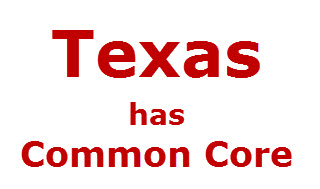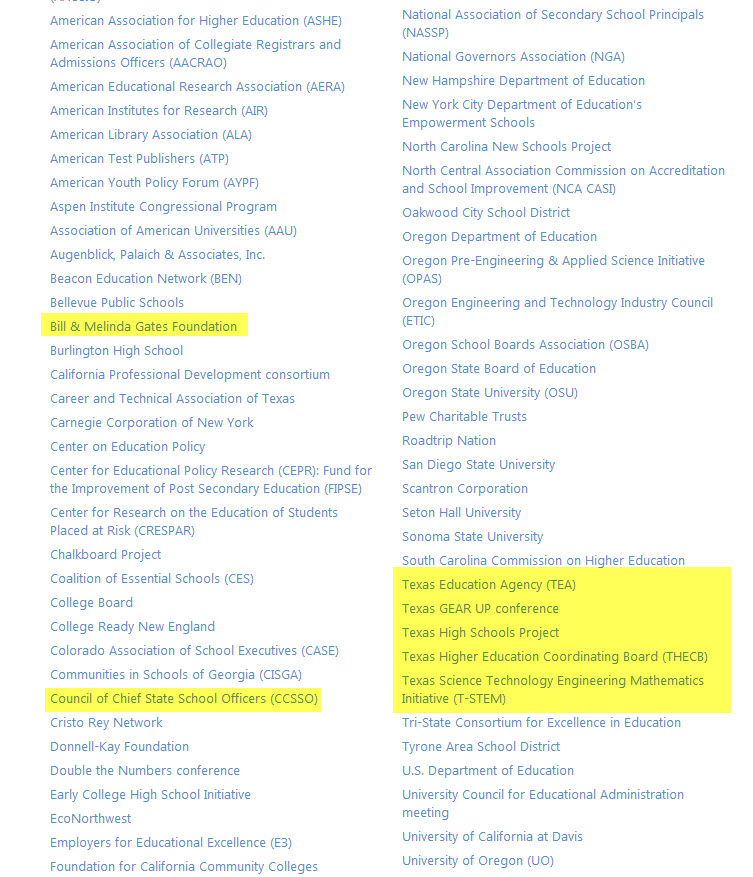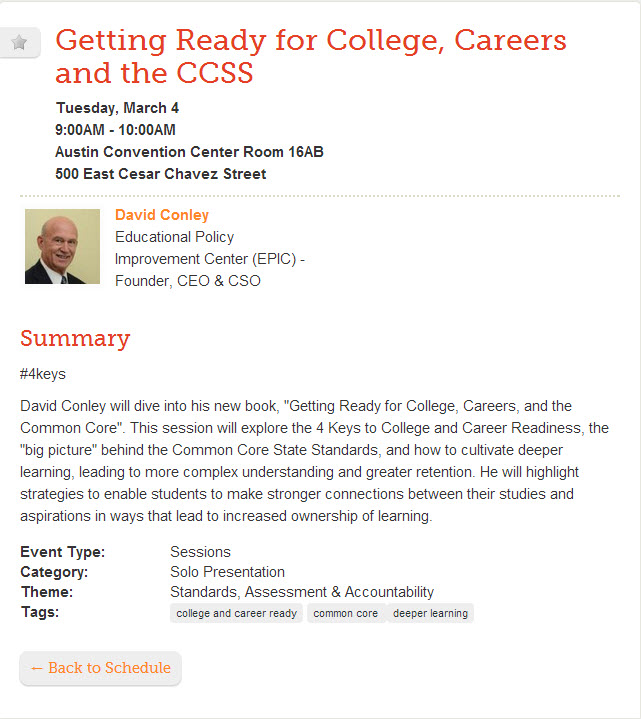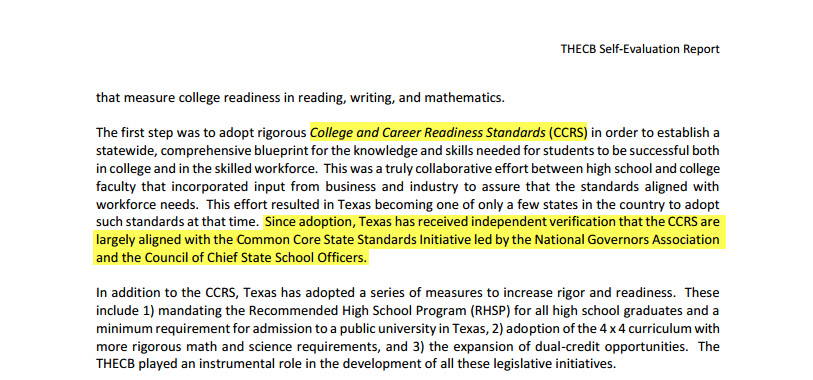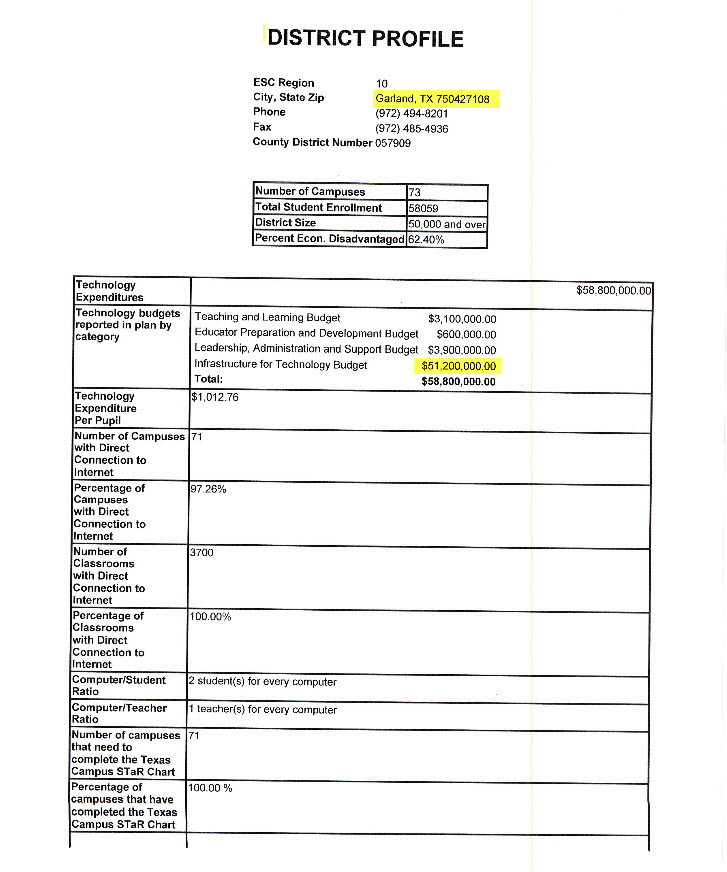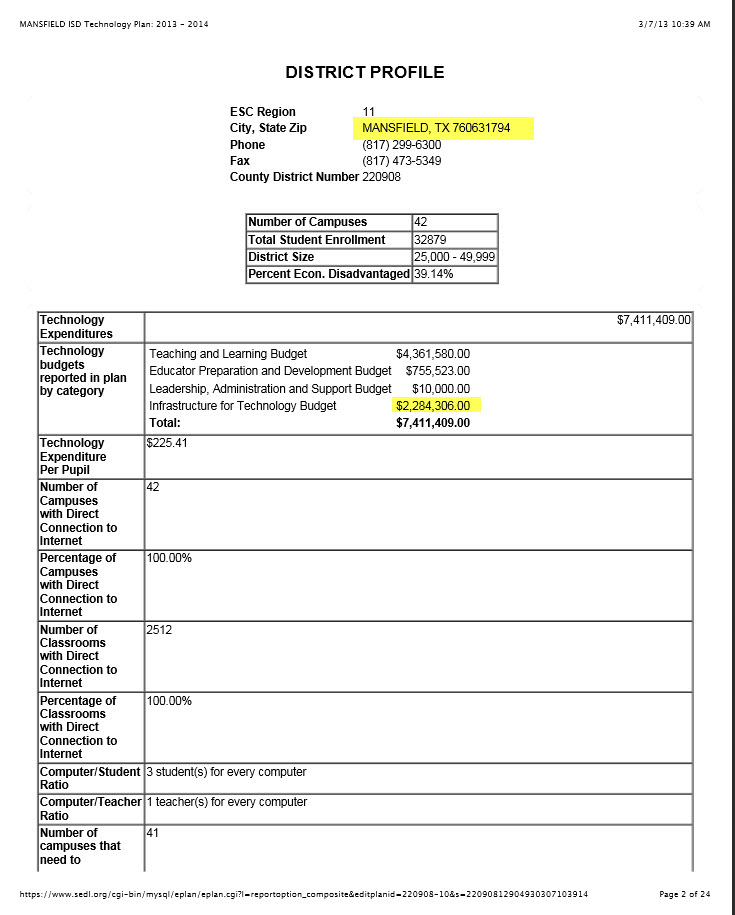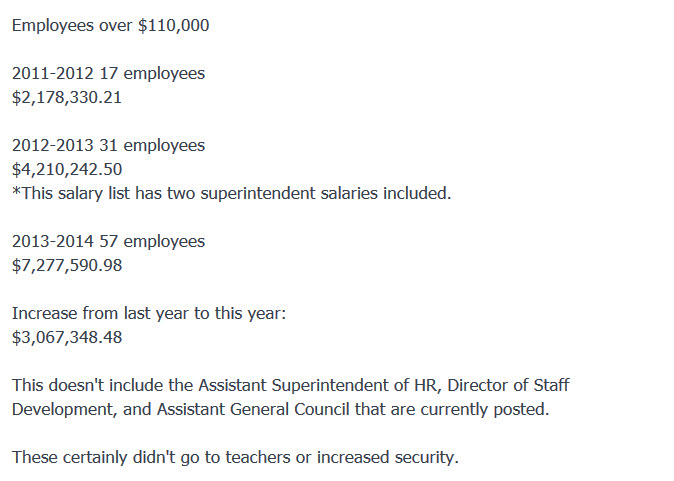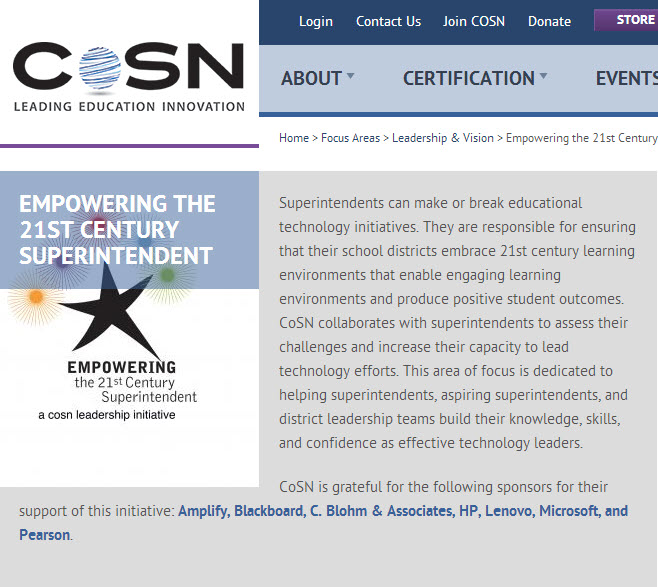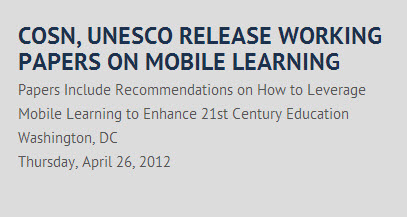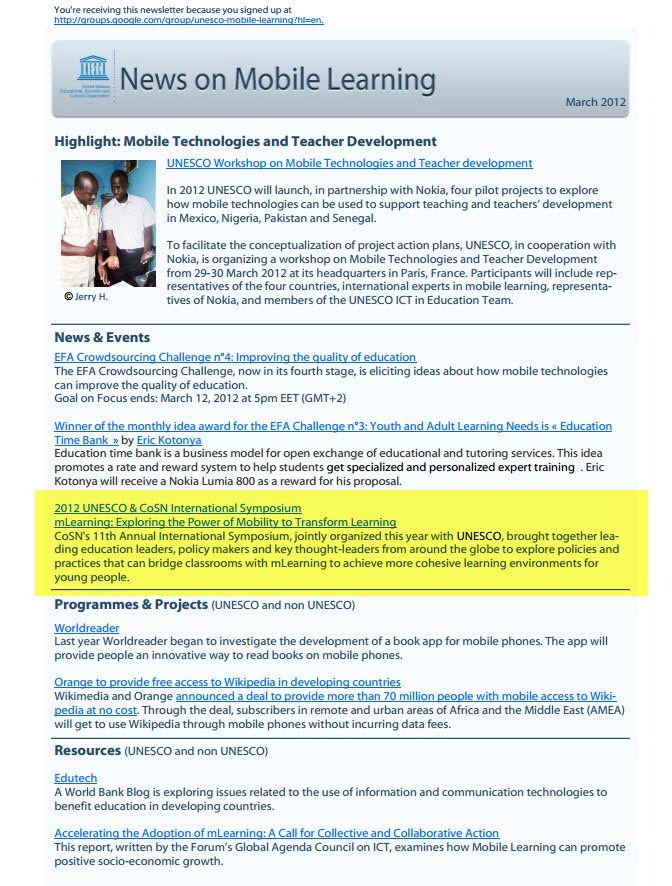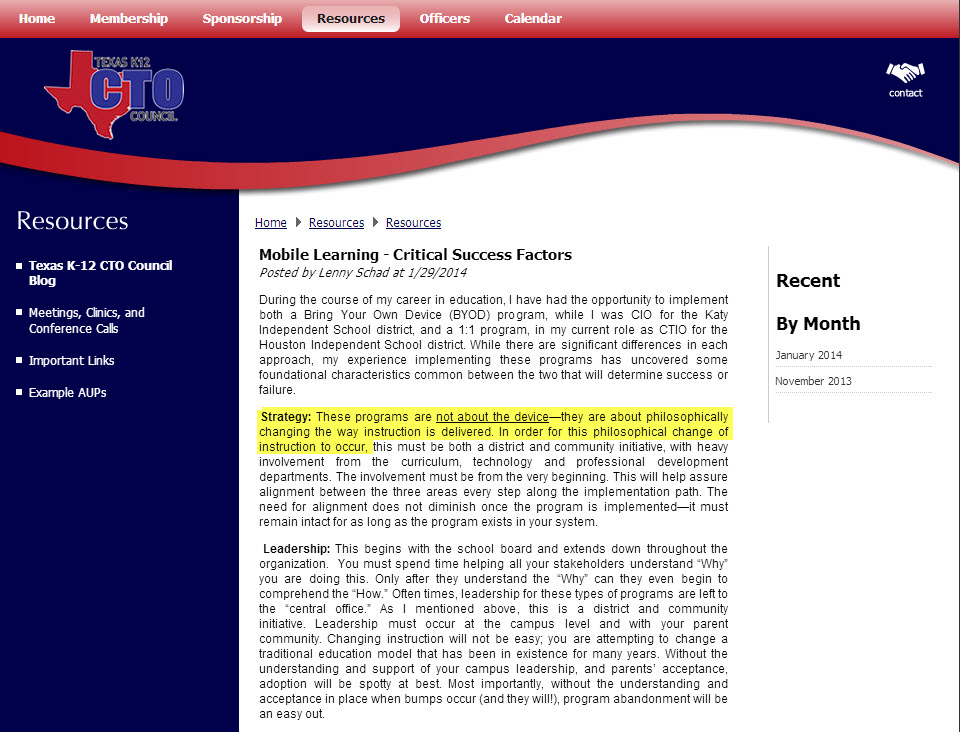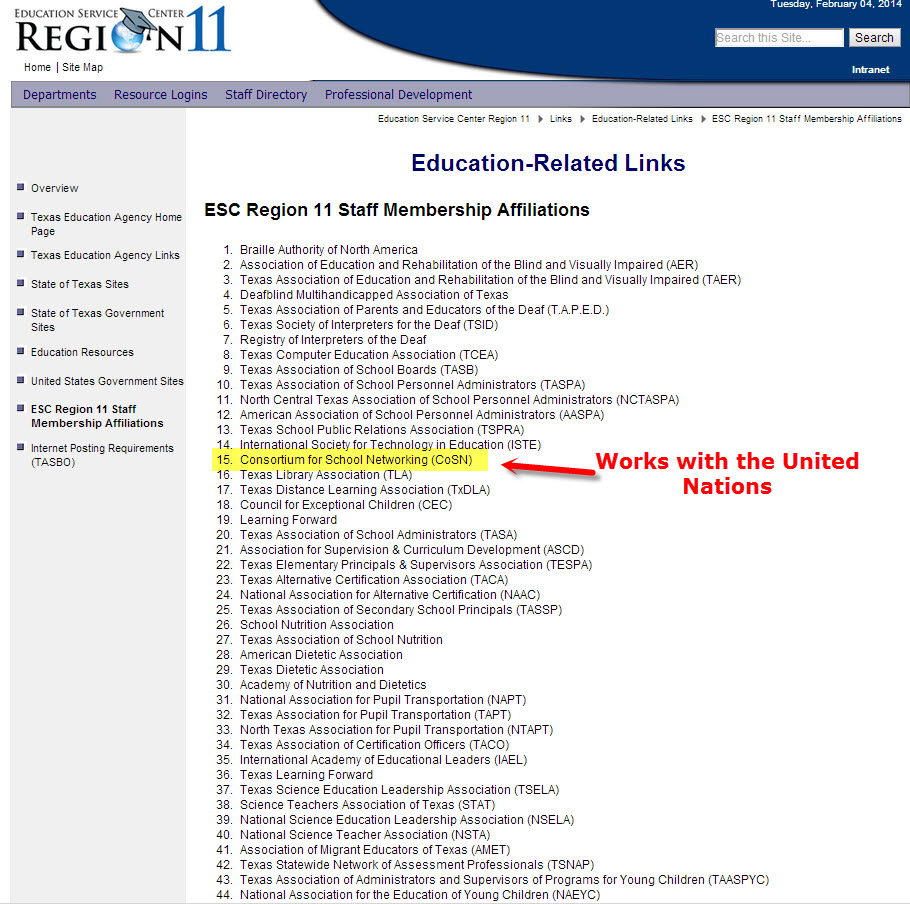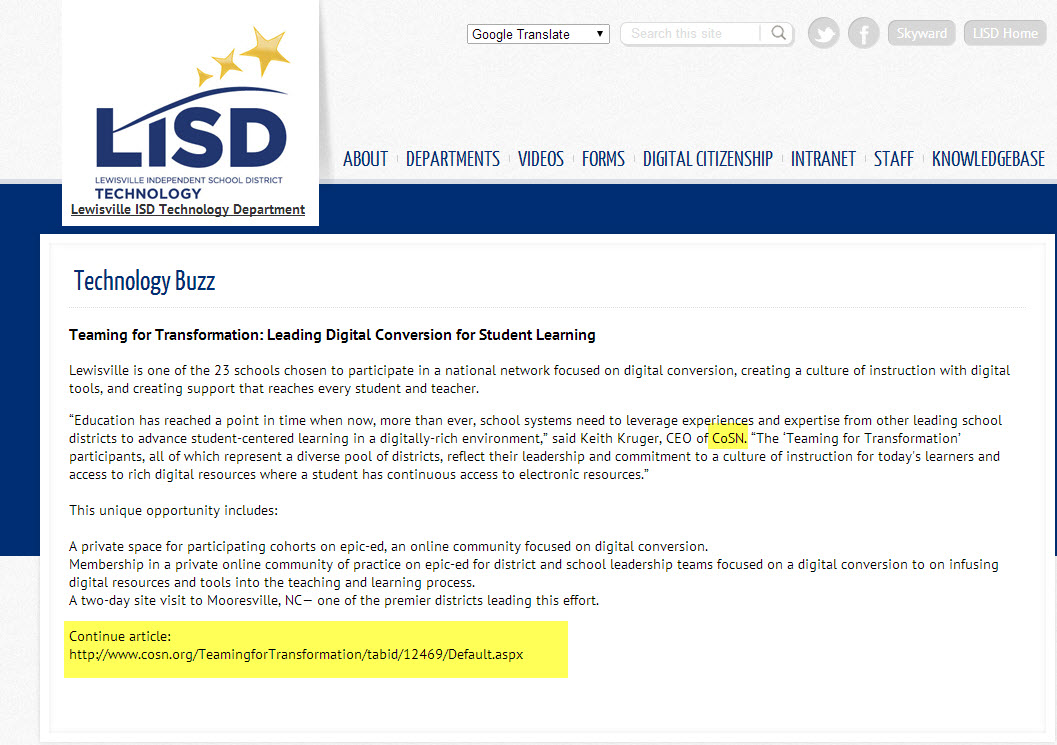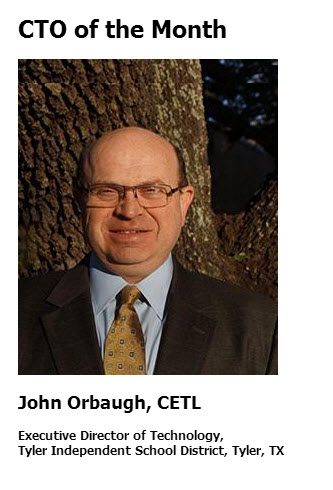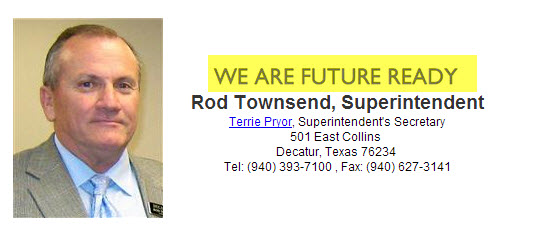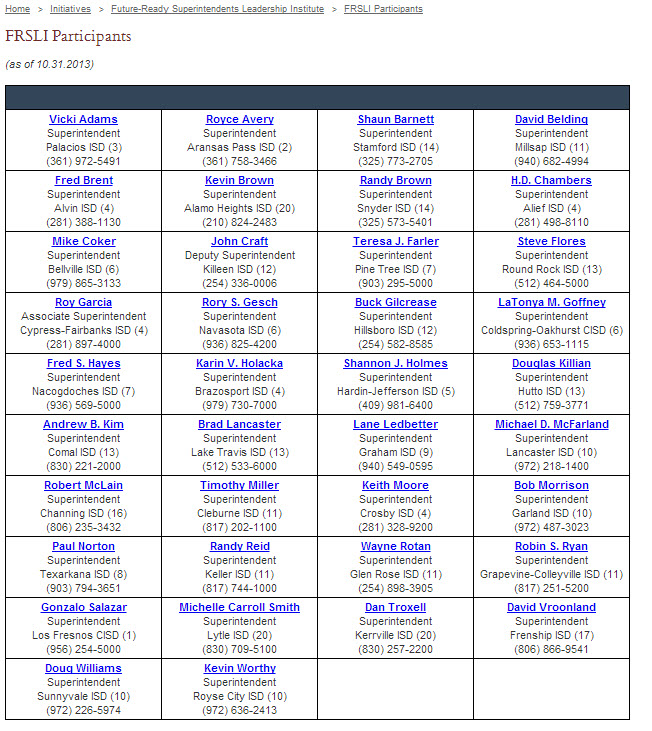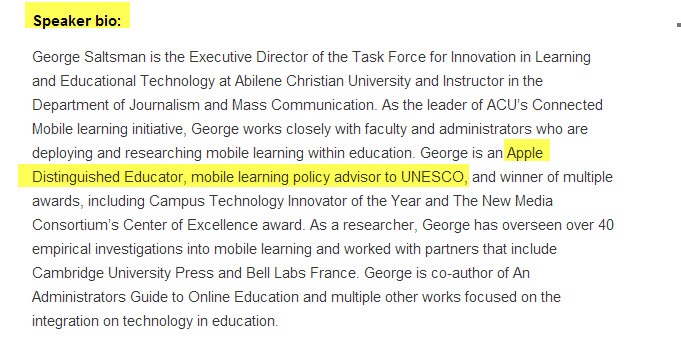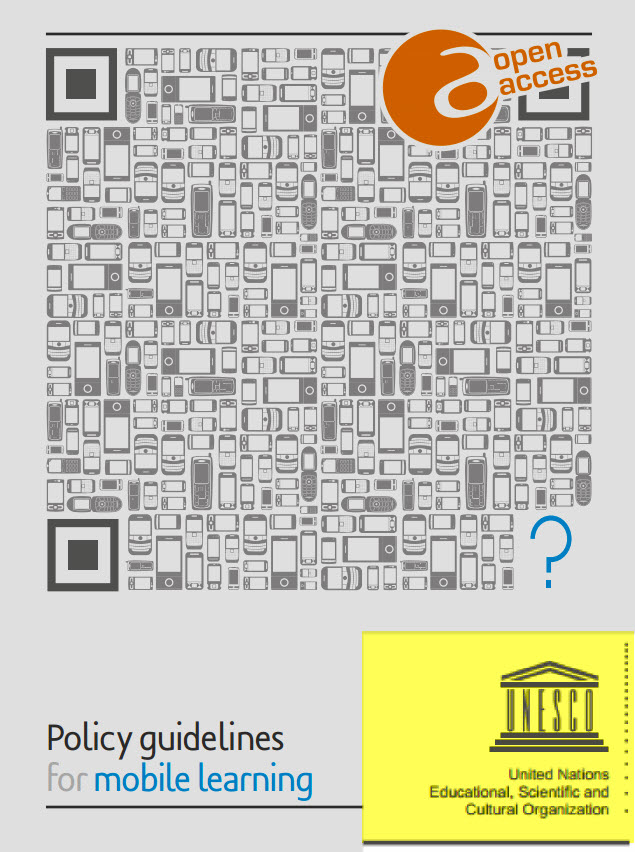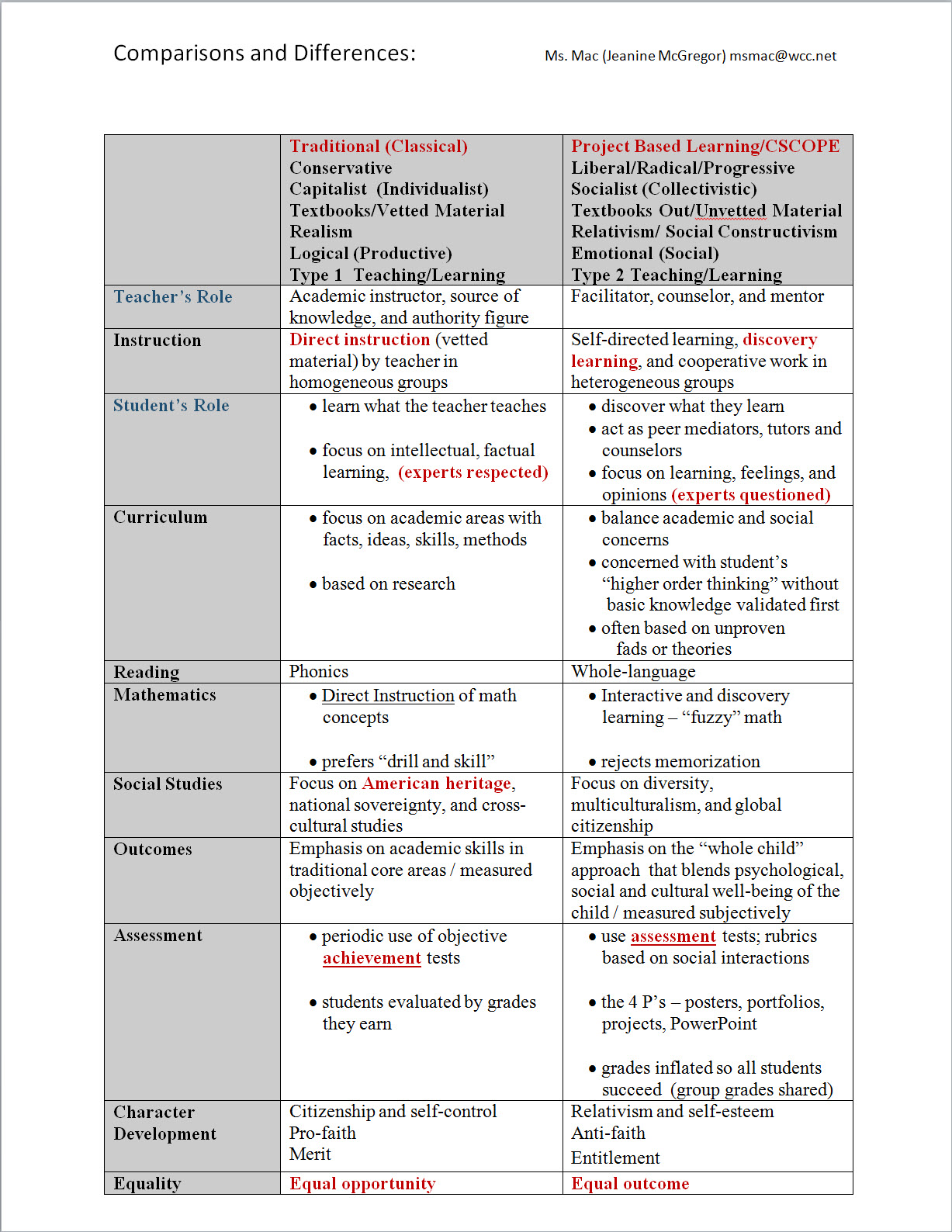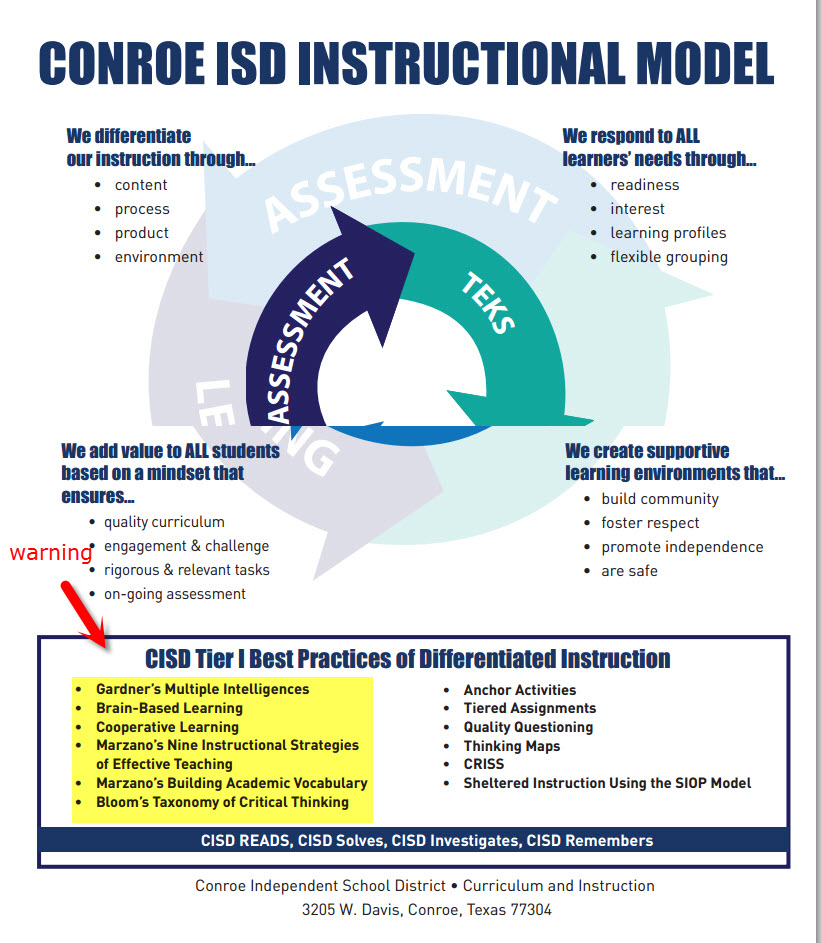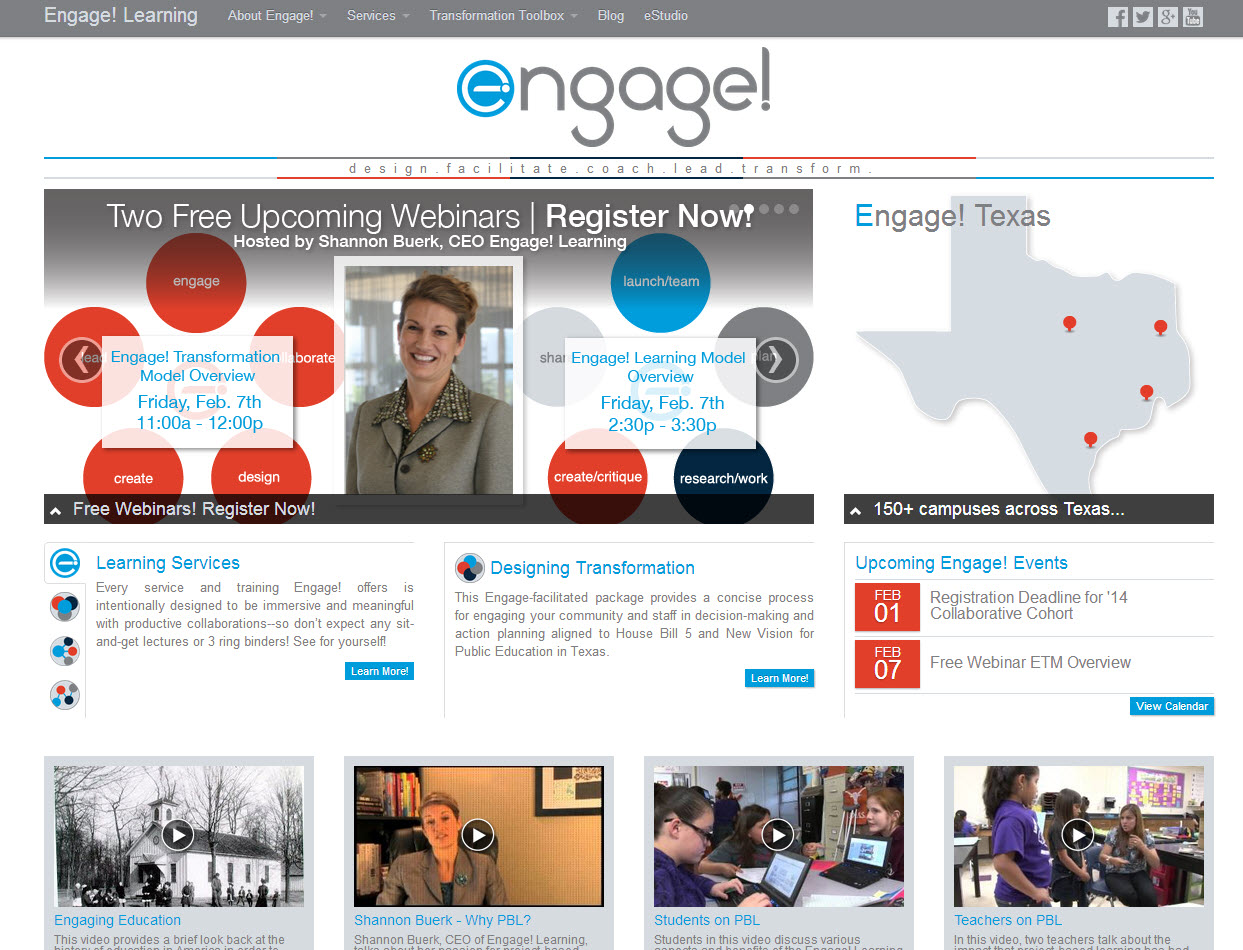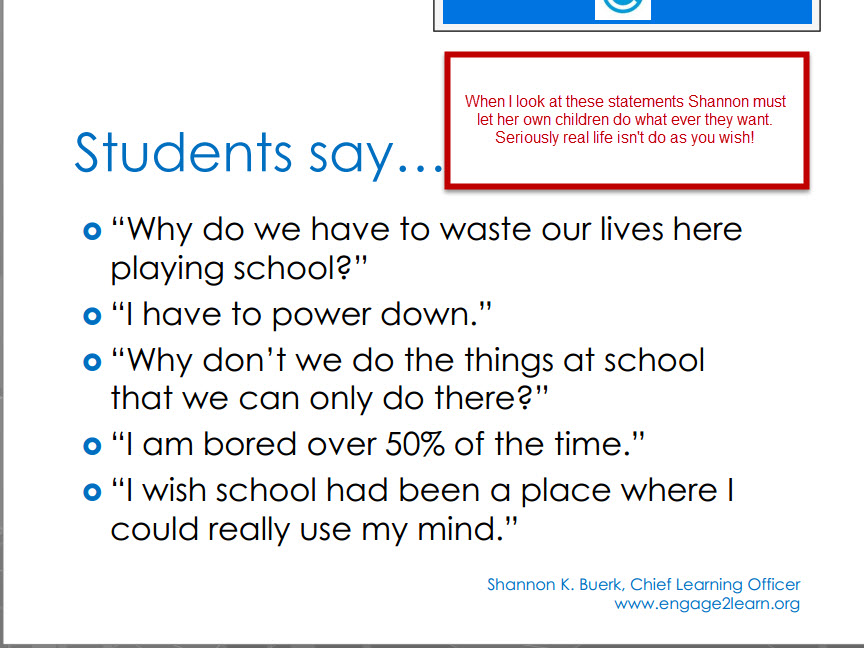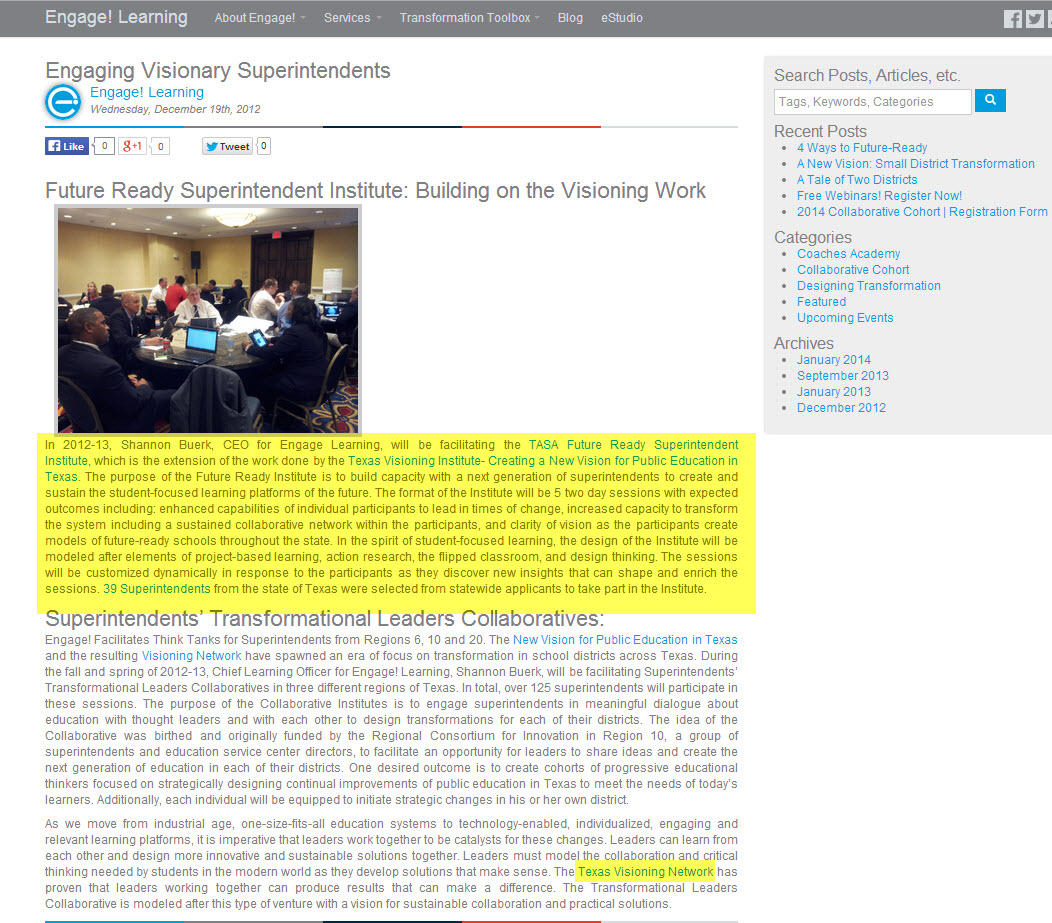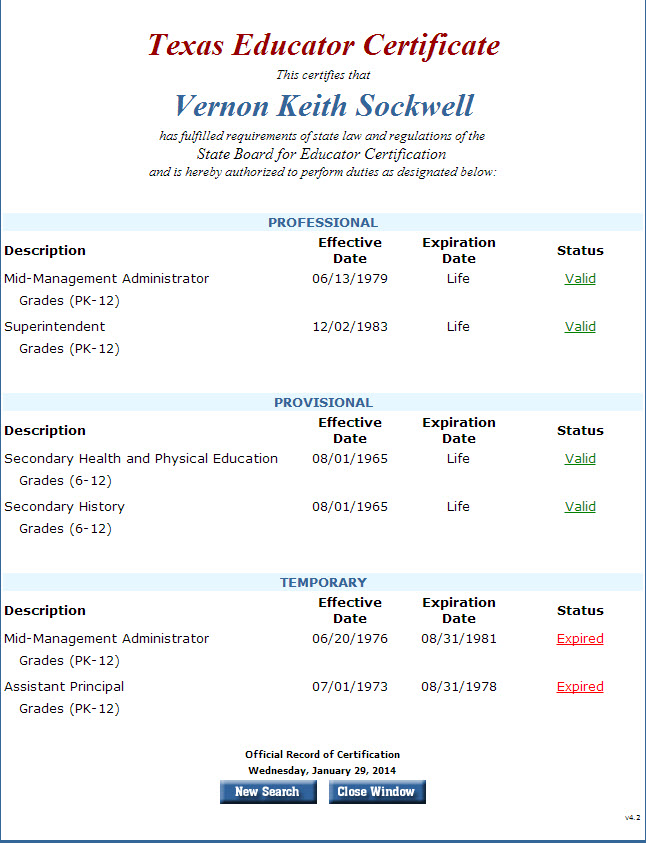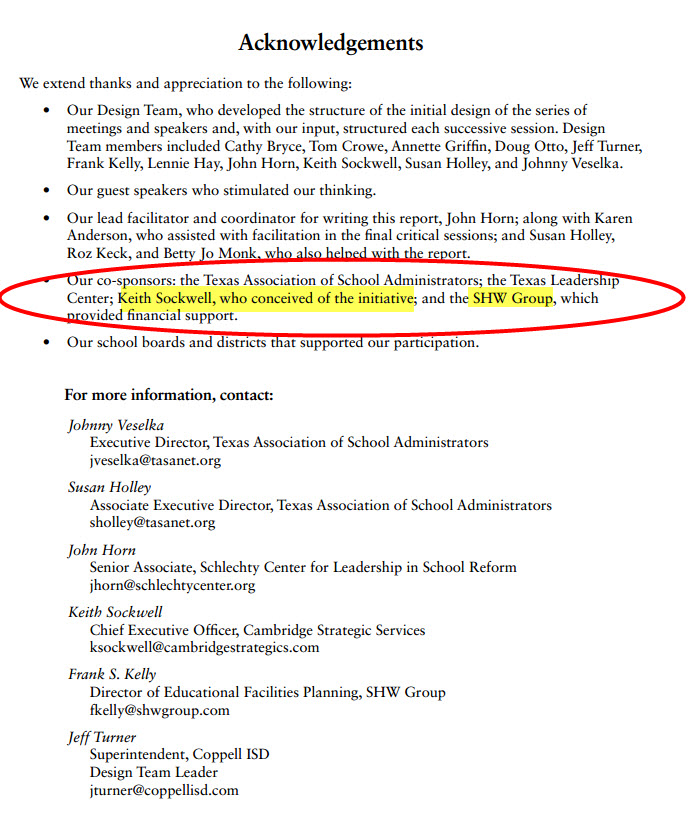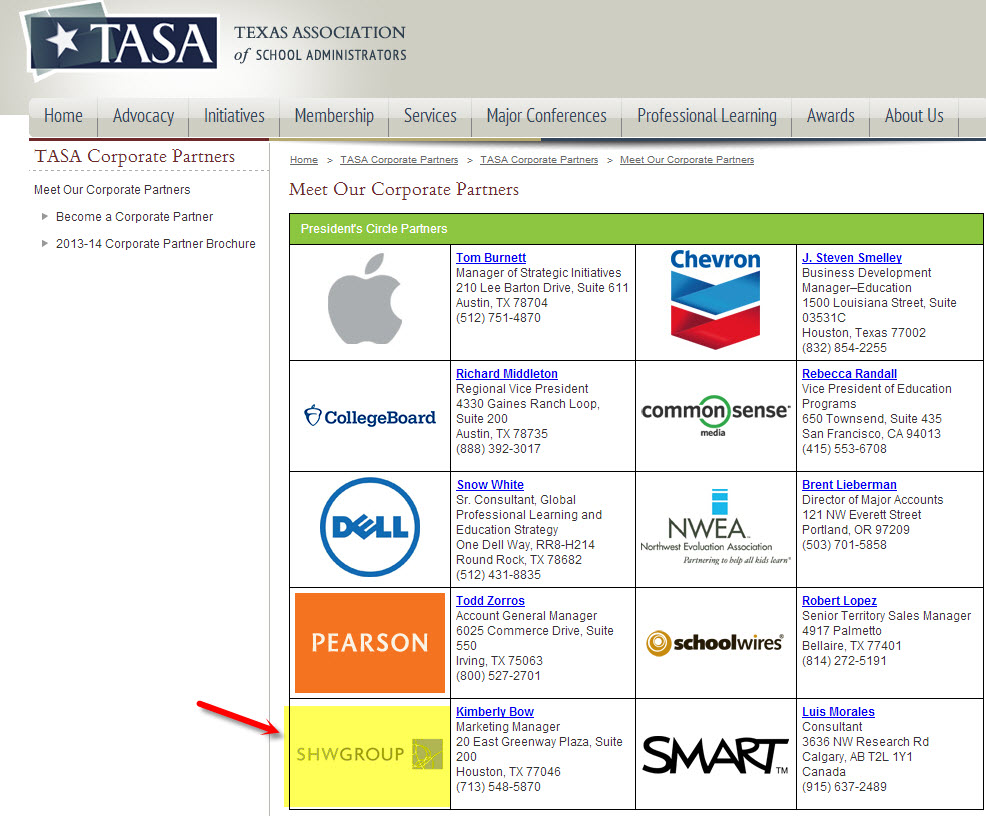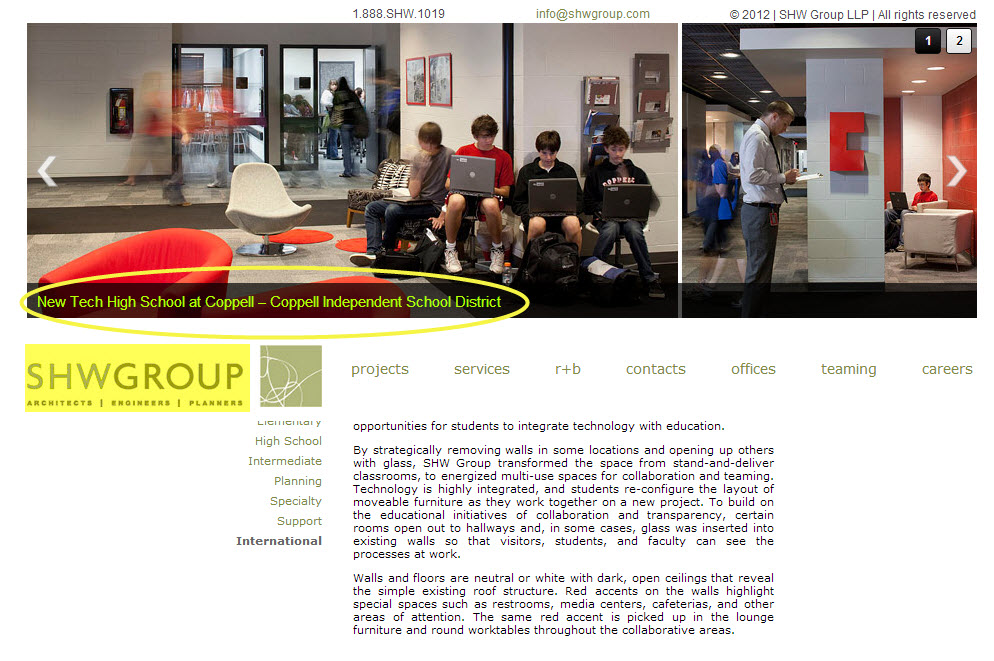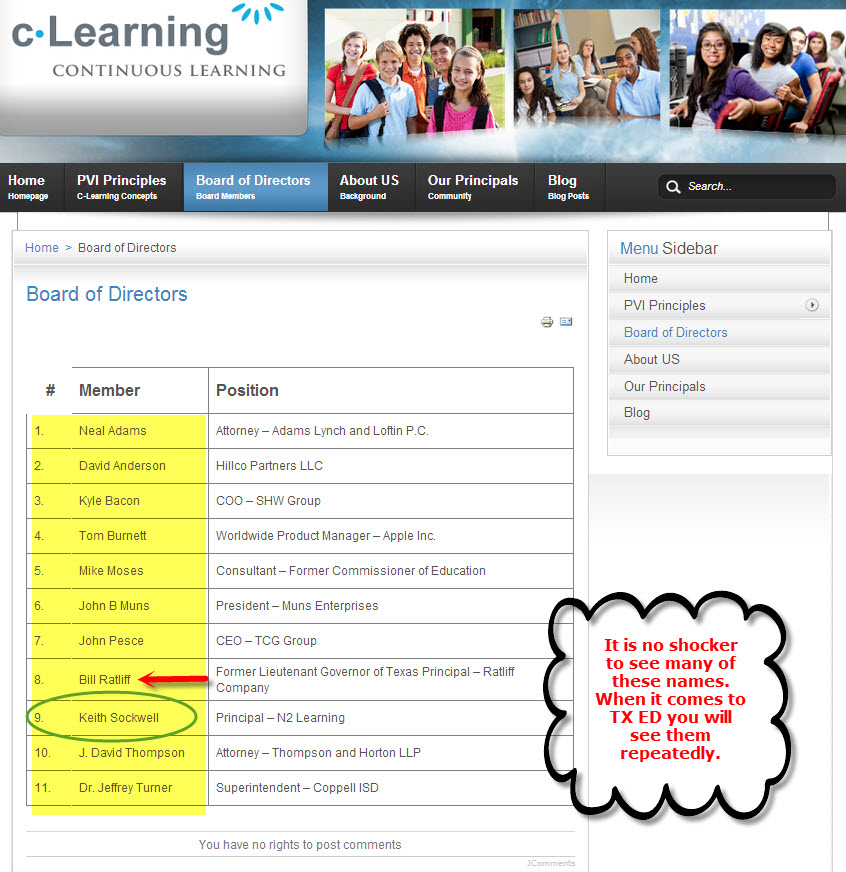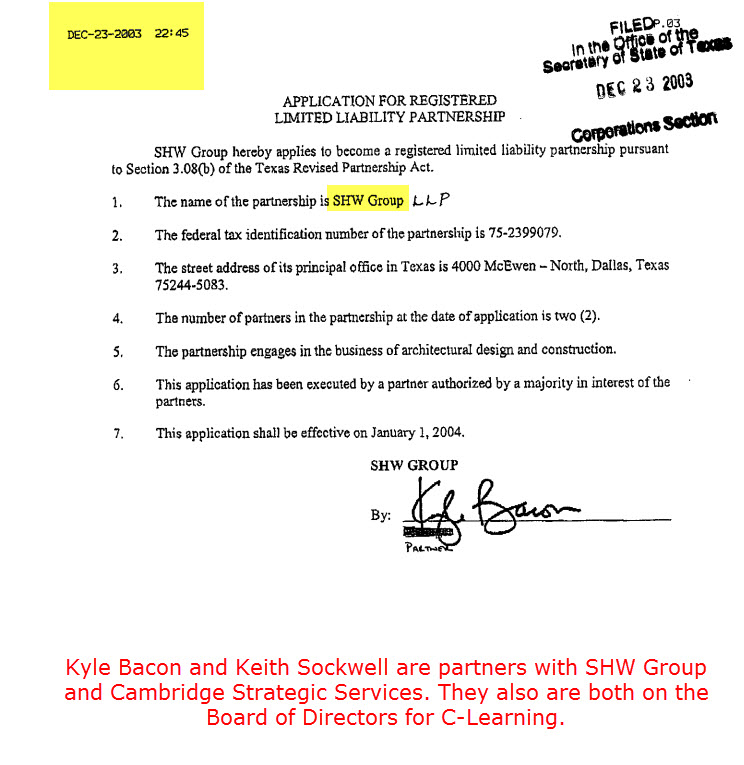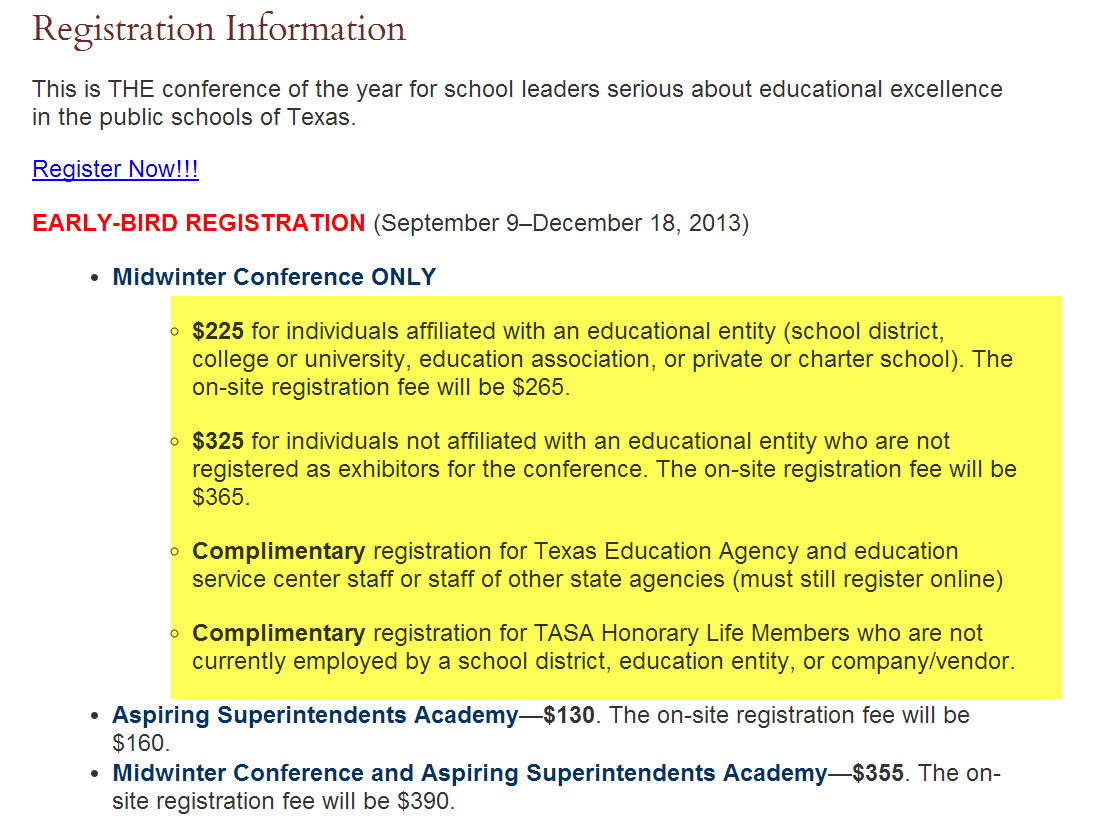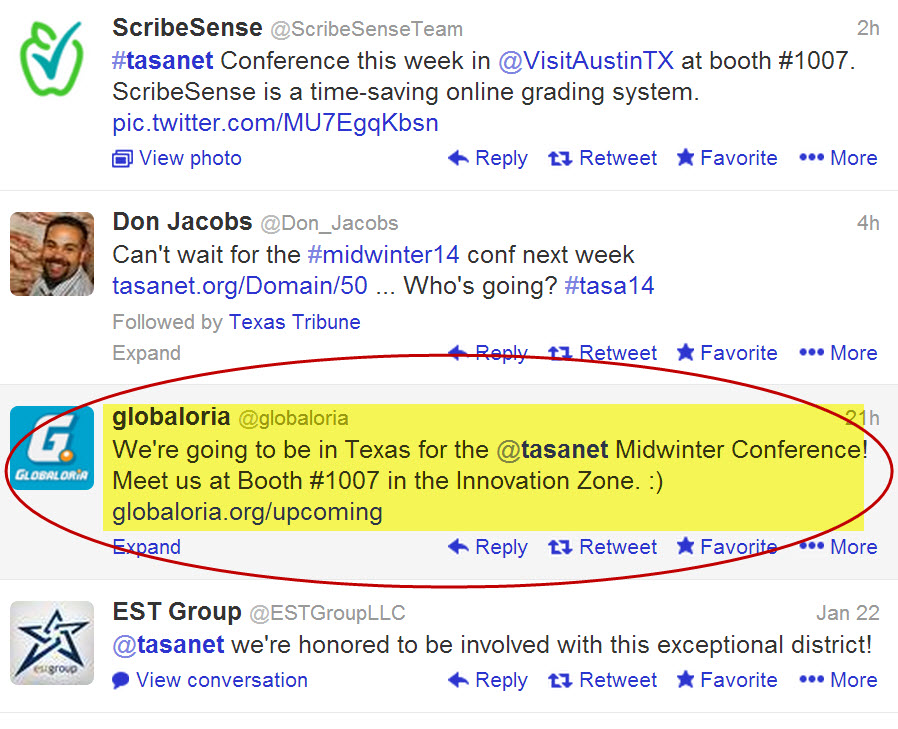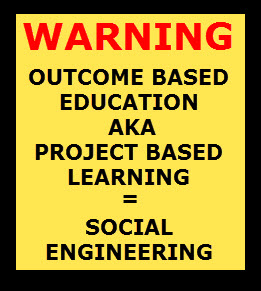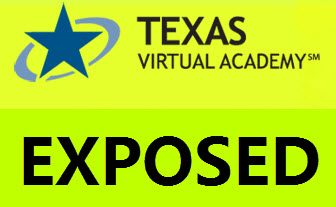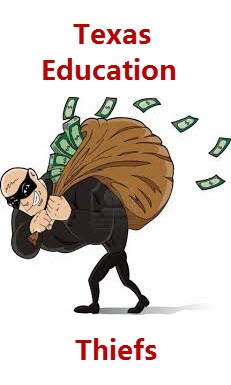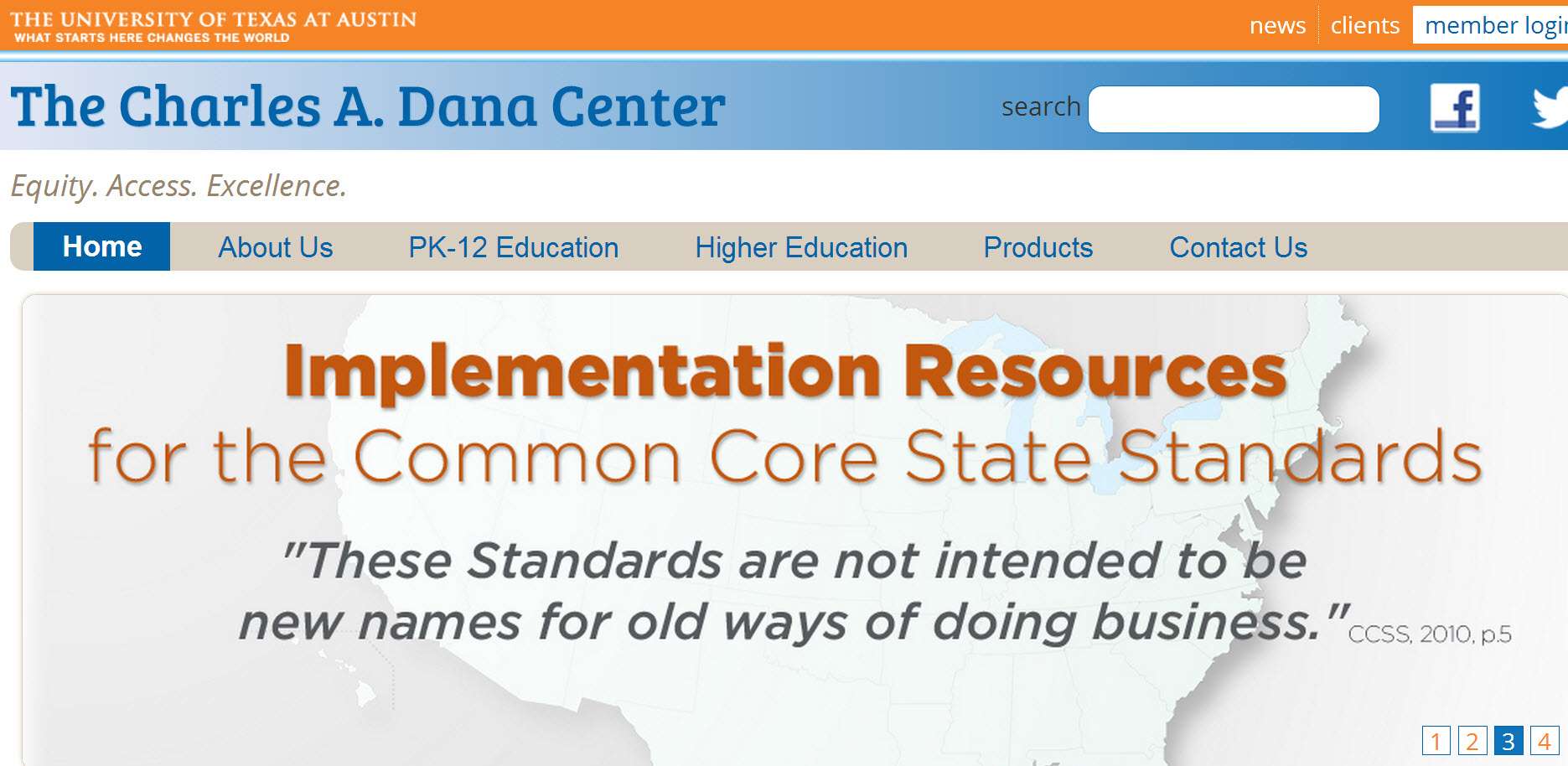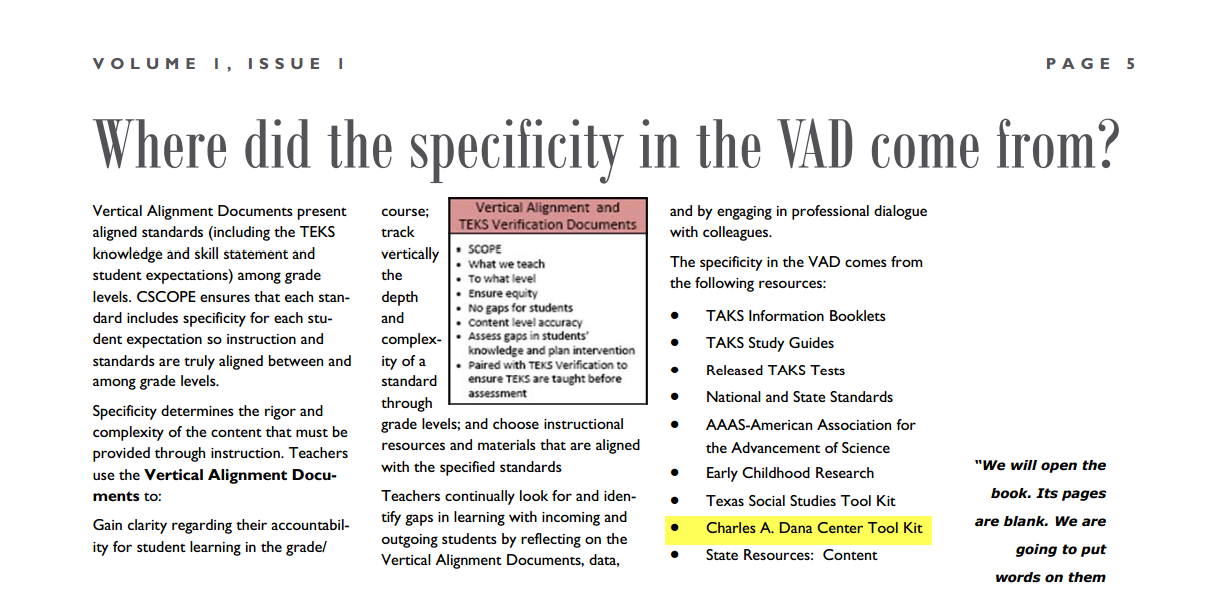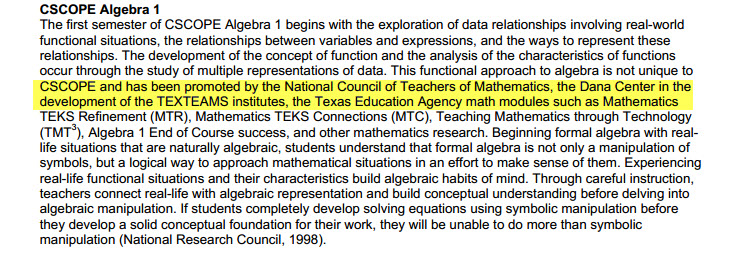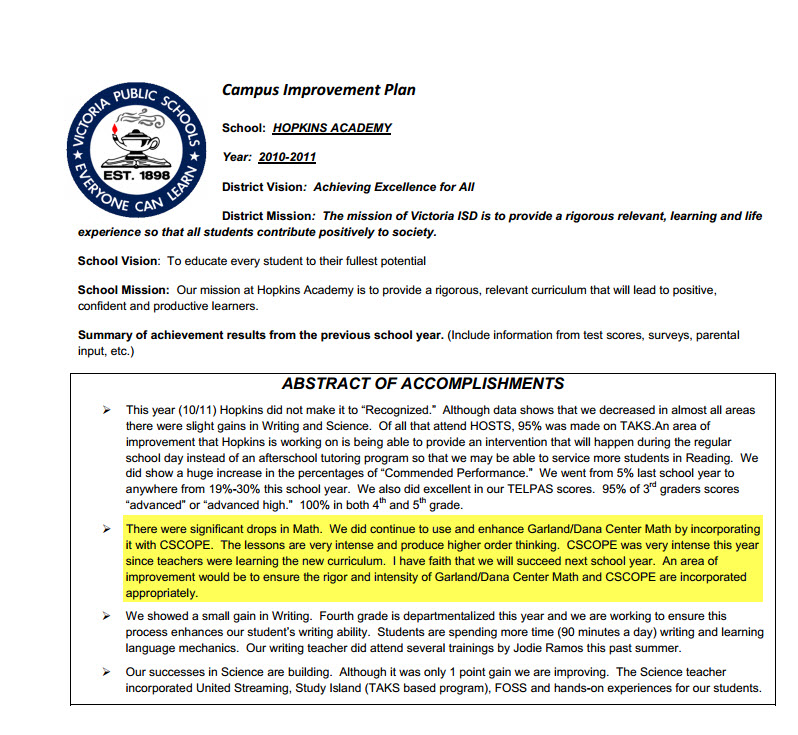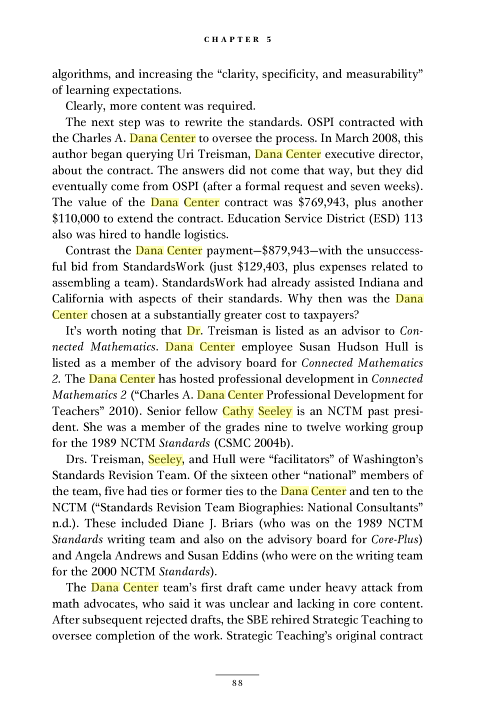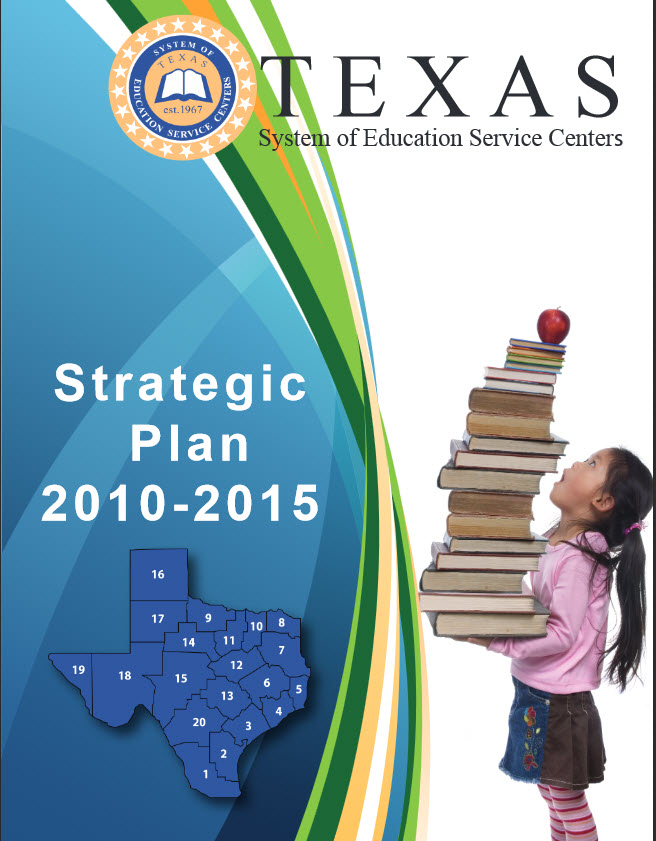
Texas Education Service Center Strategic Plan 2010-2015
2.17.14 — Below is the 2010-2015 Strategic Plan for the Texas System of Education Service Centers. I have gone through it and have inserted my comments in brackets [ ] alongside my name. It would be good for all Texas taxpayers to scroll through this document (and read my comments) so that they will know the historical background on the ESC’s and will also know what they are getting or are not getting for their tax dollars. I have placed my comments in large, bold letters for ease of reading. – Donna Garner
2010-2015
2
Adopted 2/14/2011
ESC Vision:
“World Class Educational Community
Preparing a World Class Workforce”
Core Beliefs:
• System focus on unique regional educational
needs
• Integrity/Honesty/Ethics
• Collaboration and Teamwork
• Goal and Results Oriented
• Service Oriented
• Student Centered
• Dependable
3
Adopted 2/14/2011
PARTICIPANTS
Region 1 – Edinburg
Region 2 – Corpus Christi
Region 3 – Victoria
Region 4 – Houston
Region 5 – Beaumont
Region 6 – Huntsville
Region 7 – Kilgore
Region 8 – Mount Pleasant
Region 9 – Wichita Falls
Region 10 – Richardson
Region 11 – Fort Worth
Region 12 – Waco
Region 13 – Austin
Region 14 – Abilene
Region 15 – San Angelo
Region 16 – Amarillo
Region 17 – Lubbock
Region 18 – Midland
Region 19 – El Paso
Region 20 – San Antonio
4
TABLE OF CONTENTS
Executive Summary ……………………………………………………………………………………………………………………………… 5
Major Programs and Services ……………………………………………………………………………………………………………… 6
Introduction …………………………………………………………………………………………………………………………………………. 7
History………………………………………………………………………………………………………………………………………………….. 9
Student Enrollment ……………………………………………………………………………………………………………………………. 13
Staffing/Programs/Management Initiatives …………………………………………………………………………………………. 14
Goals and Objectives …………………………………………………………………………………………………………………………. 15
TETN ………………………………………………………………………………………………………………………………………………….. 24
Appendix A: Statewide Initiatives ……………………………………………………………………………………………………… 28
Appendix B: Comprehensive School Support Plan – Service Centers ……………………………………………. 35
5
Adopted 2/14/2011
EXECUTIVE SUMMARY
In 1967, the Texas Legislature established twenty media centers in response to Title III of the
Elementary and Secondary Act passed by Congress, which provided limited funding for instruction
related training and services for teachers. As time passed, the legislature worked to expand the role of
these media centers to enhance the teaching standards in the state, and ultimately, student
performance. Today, 20 Regional Education Service Centers make up the ESC system. These centers,
located throughout the state, serve more than 4.8 million students and 659,820 administrative and
campus staff and play an integral part in ensuring the success of Texas’ education system.
Regional Education Service Centers are intermediate educational units that provide training, technical
assistance, administrative support and an array of other services as determined by the legislature, the
Commissioner of Education and the needs of local school districts and charter schools. Most often
associated with assistance to small and medium-sized school districts, the service centers have a long
history of providing assistance to all districts, including metropolitan and large suburban districts. The
third party client satisfaction survey, authorized by the commissioner, indicates that the
superintendents, principals and teachers in large suburban and metropolitan school districts rate the
work of the service centers comparable to that of small and medium-sized school district personnel.
All of these services are reviewed annually in a multi-phased review of the Education Service Centers
and the quality and effectiveness of their services as reflected in an analysis of both student
achievement and client satisfaction measures.
In recent years, the service centers have taken the lead in preparing content area teachers to meet
the ever increasing demands of the Texas Assessment of Knowledge and Skills (TAKS) and to prepare
educators for the transition to the State of Texas Assessments of Academic Readiness (STAAR).
Additionally, the service centers have been sharply focused on assisting the Texas Education Agency
(TEA) in promoting the financial health and viability of Texas school districts during rapidly changing
and more complicated financial times. No Child Left Behind (NCLB) has raised the level of
accountability Texas educators must meet. Service Centers play an active role in helping school
districts and charters understand the compliance requirements and develop strategies to successfully
implement all facets of the accountability system (see Appendixes A and B).
Section 8.002 of the Texas Education Code (TEC) defines the Education Service Center’s purpose as:
➢ Assist school districts in improving student performance in each region of the system;
➢ Enable school districts to operate more efficiently and economically; and
➢ Implement initiatives assigned by the Texas Legislature or the Commissioner of Education.
Education Service Centers address this critical mandate by providing Texas educators with solutions
that improve student performance. Service Centers work closely with school district and charter
school administrators, analyze district and school data, provide quality training to teachers,
administrators, business office personnel and school boards. Service Centers also provide countless
hours of technical assistance to educators and other education related stakeholders. ESC staff has a
thorough understanding of the student population that it serves in each region and customizes
programs and services to meet those unique regional needs.
Education Service Centers have made a significant contribution in public education. Many programs
and services support more than one of the legislative objectives. The following chart provides a profile
of the major programs and initiatives implemented by service centers in response to legislative
mandates, priorities of the Commissioner of Education, and customer needs.
|
 Page 6 Page 6
|
7
Adopted 2/14/2011
INTRODUCTION
The role of Education Service Centers (ESCs) in Texas has
changed significantly from its inception in 1965. Originally, service
centers provided educational 16 mm films to school districts.
Today, service centers play an integral part in the Texas
education system by providing educators technical assistance and
professional development using proven strategies to directly
impact success in classrooms statewide. In addition to providing
training, service centers assist school districts and charter schools
throughout the state in operating more efficiently. ESC staff
understand that learning is powerful and strive to ensure that Texas students are learning, one student
at a time.
ESC efforts have helped to improve Texas’ school districts and charter schools. In recent years, the
service centers have taken the lead in preparing content area teachers to meet the ever increasing
demands of Texas Assessment of Academics Skills and now the Texas Assessment of Knowledge and
Skills (TAKS). Additionally, the service centers have been sharply focused on assisting the Texas
Education Agency in promoting the financial health and viability of Texas school districts during rapidly
changing and more complicated financial times.
Regional Education Service Centers are intermediate educational units that provide
training, technical assistance, administrative support and an array of other services as
determined by the legislature, the Commissioner of Education and the needs of local
school districts and charter schools. Most often associated with assistance to small and medium-
sized school districts, the service centers have a long history of providing assistance to all districts,
including metropolitan and large suburban districts. The commissioner’s annual evaluation of client
satisfaction indicates that superintendents, principals and teachers in large suburban and metropolitan
school districts rate the work of the service centers as high as small and medium-sized school district
Service Centers are an important partner with TEA in serving Texas LEAs. Service Centers are
key partners in supporting the delivery of most major state educational initiatives and
technical assistance for schools and provide a full range of core and expanded services to
LEAs such as accountability, professional development for classroom teachers and
administrative leaders, instructional strategies in all areas of the statewide curriculum, and
support to struggling campuses and districts (see Appendixes A and B).
Service Centers also assist LEAs in operating more efficiently and economically through various
instructional and non-instructional cooperative and shared services arrangements, regional and
multi-regional purchasing cooperatives and other cost-saving practices that have a positive
impact on Texas schools. Service Centers also provide many administrative services to LEAs.
Some service centers include LEAs in counties that have been identified as border regions in
the Texas Government Code (TGC)§ 2056.002(e)(2) and (3), specifically, the Texas-Louisiana
and the Texas-Mexico border regions. Because many LEAs in those regions are likely to serve
students who have relocated from Mexico or Louisiana, these service centers provide
specialized training in Homeless and Migrant Education Training; professional development on
strategies to meet the needs of English language learner (ELL) students, including the use of
technological resources that are focused on language skills; health services; and testing
program assistance to help ensure accurate assessment of newly enrolled students.
Source: Texas Education Agency Strategic Plan; Fiscal Years 2011-2015
8
Adopted 2/14/2011
personnel. All of these services are reviewed annually in a multi-phased review of the Education
Service Centers and the quality and effectiveness of their services as reflected in an analysis of both
student achievement and client satisfaction measures.
Section 8.002 of the Texas Education Code (TEC) defines Education Service Center mandates as
follows:
➢ Assist school districts in improving student performance in each region of the system;
➢ Enable school districts to operate more efficiently and economically; and
➢ Implement initiatives assigned by the Texas Legislature or the Commissioner of Education.
However, the statute does not provide the ESC system with effective strategies to attain its purpose.
Therefore, it became incumbent on the system to develop a strategic plan to provide the road map
for each center, both individually and collectively, to meet the statutory directives and to attempt to
do so with decreasing state appropriations.
9
Adopted 2/14/2011
ESC History Timeline
1965 –
Title III of Elementary and Secondary Education (ESEA) Act passed by Congress
provided limited funding for instruction-related training and services for teachers.
The Texas Legislature established twenty media centers to provide Title III funded
services.
1967 –
Existing media centers were incorporated into ESEA. Title III-funded Education
Service Centers’ Legislative appropriation of $1 per average daily attendance (ADA)
provided funding for media centers and required participating districts to provide
matching funds. The role and scope of centers expanded. Centers were directed to
assist with the coordination of educational planning.
1969 –
The statewide computer services system was established in centers with $1 per
ADA funding.
1971 –
Centers received initial basic state support for regional services to schools, regional
coordination in planning and for center administrative costs.
1977 – Management and Services Audits of service centers began.
1984 –
House Bill 72 expanded centers working relationship with the Texas Education
Agency in two areas: raising the quality of school programs and bringing uniformity
and continuity to school district operations. Centers assumed new role in the area of
decentralizing services. Service Centers took on technical assistance functions in the
implementation of the Public Education Information Management System (PEIMS).
Centers took the lead in the training of local school boards.
1986 –
The State Board of Education adopted the State Plan for Regional Education Service
Centers, which defined the roles of the centers and their relationship to TEA.
Essential functions of the centers were defined.
1988 – The State Plan for Regional Education Service Centers was reviewed and updated.
1989 –
The Commissioner was authorized to enter into performance contracts with service
centers for technical assistance and other services related to accreditation, training
and curriculum as well as the implementation of PEIMS.
10
Adopted 2/14/2011
1990 –
The Price Waterhouse study of TEA recommended assigning “operational technical
assistance” to the service centers.
1992 –
The State Board of Education rules were revised providing greater authority to the
commissioner in three areas of center operations:
1) selection of center operations,
2) center budget approval, and
3) annual performance evaluation of the executive director for continued
employment.
Following a legislative mandate, TEA began decentralization of functions to service
centers including certification officers (10 FTEs) and child nutrition program
specialists (30 FTEs). Agency also establishes Field Service Agents and Partnership
Schools Initiative program and transfers 70 FTEs to service centers.
1995 –
Section 8 of Senate Bill 1 restructured service centers, identifying core services and
a market-driven structure. Rider 44 to Article III of the General Appropriations Act
of 1995 directed decentralization of several TEA functions. ESC’s role was expanded
to provide technical assistance to school districts in accreditation monitoring.
1996 –
The Commissioner conducts ESC 2000 study in preparation of sunset review of
service centers by the 75th Texas Legislature.
1997 –
The 75th Texas Legislature reauthorized the service centers and adopted a revised
Section 8 clarifying the centers’ role and function in improving student performance.
Subchapter C clearly affirms the role of the commissioner in establishing a process of
evaluation and accountability for the service centers. Section 8.102 directed the
commissioner to develop a uniform system of reporting for the service centers,
including information on client satisfaction. Section 8.103 provided for an annual
evaluation of each ESC executive director and section 8.104 provides the
commissioner with the power to sanction failing Education Service Centers.
Additionally, Chapter 8 required the provision of Core Services to school districts
within each region.
1998 –
The Commissioner entered into a contract with the Texas Center for Educational
Research to develop a third-party client satisfaction survey. The survey was piloted
in October-November 1998 and fully implemented in the spring of 2000.
11
Adopted 2/14/2011
1999 –
The 76th Texas Legislature authorized the Student Success Initiative, better known as
the Texas Reading Initiative, requiring intensive reading training for all kindergarten,
first, and second grade teachers scheduled for the summers of 1999, 2000, and 2001.
The service centers functioned as the primary administrators and providers of this
training.
2001-
The 77th Texas Legislature expanded the Texas Reading Initiative to the third and
fourth grades and authorized the implementation of intensive training for math
teachers beginning with grades five through eight. The service centers served as the
primary administrators and providers of this training.
2003 –
The 78th Texas Legislature reduced funding to service centers and ordered the Texas
School Review team to conduct a performance audit and Sunset Review of all 20
centers. [I believe this is when the idea of CSCOPE was developed because the ESC image was questioned by the 78th to the point that funding was actually reduced. – Donna Garner]
2006 –
The 79th Texas Legislature eliminated the separate Sunset Provision for service
centers and made service centers a part of the TEA Sunset process and sets the next
review for 2012.
2007 –
The 80th Texas Legislature approved twelve End of Course assessments to replace
the TAKS test.
2008 – TETN was expanded to LEARN Network tying higher education to EE-12.
2009 –
Service Centers received ARRA funds for Title 1 technical support.
State TEKS professional development dollars came to service centers to provide
professional development in the core subject areas. [This was when the ESC’s were supposed to prepare Texas educators for the new Type #1 TEKS/STAAR/EOC’s. Instead, they launched TESCCC and Type #2 CSCOPE as their emphasis and big money-maker, set up CSCOPE-specific staffers throughout the ESC’s, and managed to worm their way into 875 school districts. – Donna Garner]
The 81st Texas Legislature approved the phase out of the TAKS test and approved a
more rigorous assessment system (STAAR).
Also, House Bill 3 was approved by the Legislature, giving service centers the
opportunity to assist districts in its implementation.
4×4 requirements for graduation were implemented in the four core academic areas.
12
Adopted 2/14/2011
Student Demographics
The system of Education Service Centers is composed of 20 Education Service Centers regionally
situated throughout the state currently serving more than 4.8 million students and over 659,820
administrative and campus staff. Each regional ESC understands the unique needs of the students living
in its region. Texas is a state composed of a variety of ethnic and economic groups, which create a
uniquely diverse student population. Students living along the Texas/Mexico border have different
needs than students living in East, Central or West Texas. Consequently, it is critical that service
centers are geographically positioned to deal with the diversity within the state. ESC personnel
recognize the many challenges facing Texas students and work in partnership with educators
statewide to maximize the limited financial resources to provide the opportunity for all Texas school
children to receive a quality education.
The following exhibit summarizes enrollment by region, as well as provides the number of school
districts and charter schools served.
|
Page 13

|
14
Adopted 2/14/2011
ESC Staffing
Although organizational variances exist from center to center, the overall ESC organizational structure
is consistent throughout the state. An executive director, reporting directly to the Commissioner of
Education and to a local board of directors, oversees the daily management of each center. Under the
executive director’s supervision, centers are organized into functional units providing products and
services that best meet the needs of the districts in each region. Most ESC staff focuses on program
delivery to the school districts and charter schools within the ESC’s regional boundaries. Each ESC
has a chief financial officer or business manager who is responsible for ensuring each center maximizes
financial resources and adheres to budgetary constraints.
In September 2010, according to Texas Education Agency (TEA) reports, there were a total of 4,845
full-time employees working at Education Service Centers throughout the state, including Head Start
staff. Of that number, 2,491 were professional and 2,354 were support staff.
ESC Programs
Education Service Centers develop training opportunities for educators based on the unique needs of
students within each region. Each year, centers survey their customers/clients to determine the
programs and services needed in the upcoming school year. ESC staff closely reviews state and
regional student performance data to identify areas that need special attention. For example, low math
and science scores have been identified as a problem area throughout the state. Therefore, the ESCs
are focusing on developing better math and science skills through workshops and technical assistance
that deal specifically with providing teachers proven strategies to improve skills.
Federal programs comprise a significant part of service center programs. For instance, federal special
education funds are appropriated through TEA to service centers to assist districts and charters with
the special needs of students identified under IDEA. Special education staff at service centers helps
prepare districts and charters for federal audits, such as PBMAS, by facilitating self-assessments. During
these self-assessments, ESC staff might review records and identify areas that can be corrected prior
to the federal auditors’ actual visit. Many of the special education staff at service centers have
experience providing direct support and assistance to special needs students, such as deaf or visually
impaired students. All service centers build capacity at the district level by providing technical
assistance and training. Additionally, ESC special education staff meets regularly with special education
directors from the districts and charters to discuss current changes in
special education law and situational problems encountered on
campuses. Both special education and general education ESC staff
collaborate to help mainstream special education students to succeed
with general classroom populations.
Education Service Centers also act as the fiscal agent for many of the
federal Title programs, such as Bilingual/English as a Second Language
and Migrant Education.
The State of Texas requires every school district and charter school to submit student information,
including classroom link data, financial information and staffing information several times a year
through the state’s reporting system, the Public Education Information Management System (PEIMS).
Reporting requirements are constantly changing and are often difficult to understand. PEIMS staff at
each ESC is charged with making this process less difficult. They provide workshops and on-going
technical assistance to ensure district and charter school staff are up to date on PEIMS Data Standards
definitions and PEIMS reporting requirements. PEIMS data drives school funding and as school district
fiscal conditions become increasingly strained, it is more critical that information be reported
15
Adopted 2/14/2011
accurately. Service Centers are involved in educating campus staff of the financial impact of errors in
their PEIMS reporting. As an increasing number of campus personnel begin to understand the financial
impact reporting errors can have, data quality has improved substantially and funding has been
directed where it is truly needed. The activities conducted by service centers in these areas must
continue if data quality and reporting is to continue to improve.
Service Centers are able to bring in world-class instructors to conduct workshops for school districtsand charters that cannot afford to bring them to their own campuses. By providing workshops at thecenters, small districts can be exposed to state-of-the-art teaching strategies for a fraction of theexpense it would have otherwise cost these districts to bring in professionals of the same caliber.[This is where the Type #2, constructivist/project-based/ 21st Century Learning/TASA’s Visioning are forced upon educators; and the CSCOPE curriculum management system/TEKS Resource System are used to indoctrinate teachers as the only philosophy of education to use. The very model the ESC’s push is the model that makes them more money from the local school districts. This is a direct conflict of interest and helps them to institutionalize their staff with ever-increasing taxpayers’ dollars. – Donna Garner]
FAST
RATING
Financial Allocation Study for Texas 2010
RECOMMENDATION FOR IMPROVING YOUR DISTRICT OR CAMPUS FAST RATING
4 Work with your Regional Education Service Center (ESC) and the Comptroller’s office to identify ways your
school or district can maximize efficiencies, such as buying in bulk. Texas’ 20 Regional Service Center play an
integral role in providing essential services to school districts.
ESC Management Initiatives
The System of Education Service Centers is committed to the delivery of quality services and
products. In 2003, service centers chose to meet the quality standards as prescribed by the
International Organization for Standardization (ISO 9001:2000). Without exception, the system
continues to pursue the “Quality Journey.” Service Centers have either chosen to conform to the
quality principles through the use of an external certification body or through internal monitoring
processes. The quality management system in place in each of the service centers is designed to
enhance customer satisfaction by meeting and exceeding customer needs while complying with
applicable regulatory requirements.
Goal One: Assist the educational community in achieving educational
excellence for all students.
The ultimate goal of the ESC system is tied to achieving educational
excellence across the state. Service Centers have always been committed
to promoting educational excellence. Continuing to meet this goal is
essential to achieving the ESC mission. Assisting educators in achieving
excellence is integral to the existence of Education Service Centers. In
partnership with TEA, state legislators and educators, service centers are
committed to raising the educational standard, thus reducing the number
of Academically Unacceptable districts, charters and campuses.
One measure used to evaluate the effectiveness of the public education system is the state’s high
school completion rate. Since implementation of the national dropout definition in 2005-2006,
students have been required to return to school during the period of time between the first day of
school and the last Friday in September (the “school start window”) so as not to be considered
leavers from the prior year. The national dropout definition was fully incorporated in the completion
rate for the class of 2009. This new definition has prompted educators to take steps to ensure all
students are successful.
FAST RATING
Financial Allocation Study for Texas 2010
RECOMMENDATION FOR IMPROVING YOUR DISTRICT OR CAMPUS FAST RATING
4 Work with your Regional Education Service Center (ESC) and the Comptroller’s office to identify ways
your school or district can maximize efficiencies, such as buying in bulk. Texas’ 20 Regional Service Centers
play an integral role in providing essential services to school districts.
Source: Financial Allocation Study for Texas 2010; Susan Combs, Comptroller
4
16
Adopted 2/14/2011
The 76th Legislative session passed the Student Success Initiative ending social promotion. Beginning in
the 2002-03 school year, 3rd grade students were required to pass the reading section of the TAKS
tests in order to be promoted to the next grade level, in the 2004-05 school year, 5th grade students
were required to pass the reading and math sections of the TAKS in order to be promoted to the
next grade level, and in the 2007-08 school year, 8th grade students were required to pass the reading
and math sections of the TAKS in order to be promoted to the next grade level. The 81st Legislative
session repealed the third grade requirement that they must pass the reading portion of the TAKS
tests to be promoted, but added the more rigorous State of Texas Assessment of Academic Readiness
(STAAR) testing program to be implemented beginning in the spring of 2012. This more rigorous
testing program demonstrates Texas’ commitment to raise the academic standard and expectations
for students.
The strategic objectives focus on steps necessary to promote educational excellence. The Academic
Excellence Information System (AEIS) compares district and
charter school performance data to regional and state averages.
The state accountability system establishes state standards for
student test performance, graduation and dropout rates. Closing
the gaps between minority and non-minority passing rates and the
percentage of students taking college entrance exams and meeting
or exceeding criterion on those exams continues to be a focus.
Objective 1.1 deals directly with assisting districts and campuses
to meet or exceed the state standards as set out in AEIS. The
national No Child Left Behind (NCLB) legislation, addressed in
Objective 1.2, has added another layer to school accountability
that service centers must help schools understand and must assist
them in meeting or exceeding these more rigorous standards.
Additionally, the state has implemented new financial
accountability standards for public schools, and service centers
are instrumental in assisting districts and charters with these
standards as stated in Objective 1.3. Service Centers, by
recruiting and retaining qualified staff, have the expertise to positively impact raising the educational
standards and helping educators provide a high quality education to every student.
[Not only do local school administrators detest having the STAAR/EOC’s given at each grade level/course level, but also the ESC’s detest it because they are supposed to be held accountable for raising the academic indicators of the schools in their regions. Even though the ESC’s supposedly are not to get involved with legislative bills, I feel sure they found a way to work “in the backroom” with various advocacy groups to pressure the 83rd Legislative Session to pass HB 5/HB 866. Not only do these two bills destroy the authentic education reform that took us 15 years to put in place; but the bills set forth a new accountability system, much of which will be based upon subjective rather than objective criteria (e.g., Community Performance Rating).
All ESC staffers have strong and constant relationships with the school administrators and personnel from around the state. They meet together frequently in buildings that are paid for with our tax dollars. Most school personnel are allowed to leave school on school time to attend these meetings. It is easy for the school administrators/personnel to meet in the ESC facilities to plot their legislative initiatives and the means through which they can pressure legislators to fall in line. – Donna Garner]
Objective 1.1: Assist in increasing the number of districts/campuses/charters in meeting
or exceeding state standards for student performance (see Appendix B).
Texas state statute requires districts and charter schools be rated annually and awarded an
accountability rating of Exemplary, Recognized, Academically Acceptable, or Academically
Unacceptable. These ratings along with student performance information are published in the AEIS
report each year.
TEA’s accountability plan procedures have changed due to the transition from the current
accountability rating system that uses the Texas Assessment of Knowledge and Skills (TAKS), to the
new accountability system that uses the State of Texas Assessments of Academic Readiness (STAAR).
Beginning in 2012, the accountability rating system for Texas public schools and school districts will be
based on new, more rigorous testing requirements. The accountability rating system for Texas public
schools and school districts is comprised of two sets of procedures – standard and alternative
education. Standard procedures result in ratings assigned to standard campuses (including non-
registered alternative education), while alternative education accountability (AEA) procedures result in
ratings assigned to registered alternative education campuses (AECs).
To determine ratings under the standard accountability procedures, the accountability rating system
for Texas public schools and districts use four base indicators:
Objective 1.1:
Assist in increasing the number of
districts/campuses/charters in meeting or
exceeding state standards for student
performance.
Objective 1.2:
Assist in increasing the annual number of
districts/campuses/charters in meeting or
exceeding NCLB standards for student
performance.
Objective 1.3:
Assist districts/charters in
meeting/exceeding the state financial
accountability rating of standard
achievement.
17
Adopted 2/14/2011
➢ Performance on the Texas Assessment of Knowledge and Skills (TAKS),
➢ Performance on the TAKS Alternative, TAKS Accommodated and TAKS Modified,
➢ Completion Rate, and
➢ Annual Dropout Rate for grades 7 and 8.
Districts and campuses can achieve a rating by meeting the absolute standards for the different
indicators, or under certain conditions, by meeting Required Improvement (RI) and/or by using the
Exceptions Provision, or by virtue of the Texas Performance Measure (TPM).
To determine ratings, the alternative education accountability (AEA) procedures
➢ Performance on the Texas Assessment of Knowledge and Skills (TAKS),
use four base
indicators:
➢ Performance on the TAKS Alternative, TAKS Accommodated and TAKS Modified,
➢ Completion Rate, and
➢ Annual Dropout Rate for grades 7 through 12.
Alternative education campuses (AECs) can achieve a rating by meeting the absolute standards for the
different indicators. However, under certain conditions, AECs can achieve a rating by meeting
Required Improvement (RI), Texas Projection Measure (TPM), and/or by using the accountability data for
at-risk students in the district.
The 79th Legislature’s Third Called Special Session established accreditation levels for districts of
accredited, accredited-warned, accredited-probation, and accredited-revoked and required the
accreditation status to be determined based upon the academic accountability system as well as the
financial accountability rating system.
This objective will require center staff to continue conducting comprehensive data analysis of districts,
campuses and charters to identify those that are not meeting or exceeding state standards. Service
Centers have developed a system wide Technical Assistance Plan to assist districts, charters and
campuses that have been identified as Academically Unacceptable (see Appendix B). In addition to
reviewing and analyzing test scores, service centers will also look at closing the achievement gap,
graduation rates, ACT or SAT tests, and high school completion rates.
Objective 1.2: Assist in increasing the annual number of districts/campuses/charters in
meeting or exceeding NCLB standards for student performance (see Appendix B).
In addition to AEIS state standards, Texas districts, campuses and charters are accountable for
meeting national standards from the No Child Left Behind Act (NCLB). The act requires each state
develop and implement a plan that is effective in ensuring that all local education agencies, public
elementary and secondary schools make adequate yearly progress as defined under this act. States
must describe how they will close the achievement gap and ensure all students, including
disadvantaged students, achieve academic proficiency. Under the act, states must produce annual state
and school district report cards that inform parents and the communities about their progress.
Adequate Yearly Progress (AYP) Indicators include:
• Reading/Language Arts performance and participation
• Mathematics performance and participation
• Graduation Rate
• Attendance Rate
18
Adopted 2/14/2011
Title I districts, campuses, charter schools, and alternative education campuses are subject to
implement after not meeting AYP for two or more consecutive years:
Districts:
Stage 1: Revise District Improvement Plan
Stage 2: Implement revised District Improvement Plan
Stage 3: District Corrective Action
Campuses:
Stage 1:
• Revise Campus Improvement Plan (CIP)
• Technical Assistance provided as campus develops and implements CIP
• Parent Notification Requirement
• School Choice/Transportation
Stage 2: Supplemental Educational Services
Stage 3: Corrective Action
Stage 4: Restructuring
Stage 5: Alternative Governance
19
Adopted 2/14/2011
2010 Preliminary AYP Status
Texas School Districts and Charters Results
Source: TEA, Website address. http://www.tea.state.tx.us/ayp/2010/index.html
Implementing this objective will require center staff to continue conducting comprehensive data
analysis of districts, campuses and charters in order to develop and implement strategies to increase
the number of schools that meet or exceed the NCLB standards. This will include providing technical
assistance to schools in need of improvement (see Appendix B). In addition to reviewing and analyzing
test scores, service centers will also review graduation and attendance rates.
Objective 1.3: Assist districts and charters in meeting and/or exceeding the state financial
accountability rating standard of achievement.
The 77th Legislature directed the Commissioner of Education, in consultation with the Texas State
Comptroller’s office to “…develop and implement a financial accountability rating system for school districts
in the state.” In response to this directive, TEA developed the Financial Integrity Rating System of
Texas (FIRST), which was fully implemented in 2003-04 using school districts’ 2002-03 financial data.
TEA developed a template that schools can use to project their rating before the official rating is
released by TEA. The rating worksheet, along with accompanying calculation instructions, was
adopted in 19 TAC §109.1002 to be effective October 20, 2002, and later amended to be effective
May 7, 2003. Schools receive ratings from “substandard achievement” to “superior achievement.” The
79th Legislature’s Third Called Special Session established accreditation levels for districts of
accredited, accredited-warned, accredited-probation, and accredited-revoked and required the
accreditation status be determined based upon the academic accountability system as well as the
financial accountability rating system.
Beginning with fiscal year 2008-2009, the financial accountability rating of a school district is based on
its overall performance on certain financial measurements, ratios, and other indicators established by
the Commissioner of Education in the financial accountability form entitled “School FIRST – Rating
Worksheet, March 2010.”
20
Adopted 2/14/2011
Implementing this objective will require service center staff to provide access to data related to
financial accountability standards to districts on a timely basis and provide training and technical
assistance to district personnel and school boards.
Goal Two: Improve capacity to serve as a system to maximize
efficiency.
Education Service Centers can serve school districts
and charters more effectively and efficiently by
operating as a system. Service Centers shall be
evaluated as a system by the Commissioner of
Education to determine effective and efficient delivery
of services to school districts and charters.
Education Service Centers are a vital link in the
educational process providing a direct, immediate
contact with all school districts within their respective
regions. Service Centers within this role identify and
are responsive to the needs of the local public
schools and charters. Each ESC customizes services
to best meet the needs of the districts and charters
within their region.
Education Service Centers continue to explore opportunities to maximize efficiency through
collaborative efforts. Such collaboratives include, but are not limited to, other Education Service
Centers, Institutions of Higher Education, private sector, public sector, the Texas Education Agency,
and other state agencies.
Strategic objectives are established to ensure that Education Service Centers maximize efficiency by
operating as a system:
Objective 2.1: Maintain a quality system for ESC operations to maximize public school
efficiencies.
Education Service Centers shall routinely conduct needs assessments. Such needs assessments shall
include third-party evaluations, regional evaluations, and analysis of key performance indicators,
advisory groups, and results from federal and state accountability standards. Based on the results of
the needs assessments, Education Service Centers will design quality programs, products, and services
to maximize efficiencies for districts and charter schools. Service Centers shall be committed to
providing quality services to school districts and charter schools at a reasonable cost.
Objective 2.2: Provide awareness and assistance in implementation of practices.
House Bill 1 mandated that public education best practices be identified and disseminated on a
statewide basis. The Education Service Centers assisted in the development of a process to identify
and disseminate successful educational practices while incorporating best practices into trainings.
Objective 2.3: Maximize technology and other resources to improve and enhance
customer service.
Technology is an essential tool within the educational community. Education Service Centers work to
leverage technology more effectively to facilitate delivery of training and in assisting the educational
Objective 2.1:
Maintain a quality system for ESC operations
to maximize public school/charter efficiencies.
Objective 2.2:
Provide awareness and assistance in
implementation of best practices.
Objective 2.3:
Maximize technology and other resources to
improve and enhance customer service.
Objective 2.4:
Recruit, develop and retain qualified staff
across service centers in order to meet
customer needs.
21
Adopted 2/14/2011
community in finding new ways to integrate technology into instruction and operations. The system is
committed to expanding its technology infrastructure to provide more on-line and distance learning
opportunities for Texas students. This allows students access to coursework that is unavailable on-
site and broadens the educational experience. Implementation requires staff to remain abreast of all
new instructional applications that benefit ESC customers.
Objective 2.4: Recruit, develop and retain qualified staff across service centers in order
to meet customer needs.
The success of the ESC system is dependent on the quality of staff. Service Centers employ some of
the most gifted and dedicated educators in the state. Recruiting and retaining the highest level of
professionals and support staff is instrumental to our continued ability to provide high quality
programs and services.
[Yes, ESC’s do employ many staffers. In fact, teachers who plan to retire from the classrooms love working for the ESC’s either full time or as consultants who can “double dip” with TRS funds and also ESC salaries. Of course, to get hired by the ESC’s, teachers need to impress the ESC staffers with their Type #2 expertise; and that is why many teachers try to cultivate relationships with the ESC staffers. I am convinced that it is this cultivation mechanism that caused teachers to submit their Type #2 lesson plans for no remuneration and with no attribution clauses in place to protect teachers’ property. Those lessons written by various and sundry people turned into the scatter-shot, Type #2 CSCOPE lessons that are not connected to each other cognitively. For the student, this means that there is no long-term memory developed through a systematic progression of the CSCOPE lessons. – Donna Garner]
In order to continue to provide high quality training and technical assistance, ESC personnel must
maintain their own ongoing professional development to remain experts in their fields and to continue
to provide high quality training and technical assistance. This requires researching the latest training
concepts and teaching strategies as well as remaining abreast of any legislative changes. By pooling
resources, service centers are able to jointly develop services that are responsive to the dynamic
needs of their customers.
Implementing this objective requires ESCs to develop core competencies that any new employee must
have to be hired. Job descriptions are closely reviewed to ensure the skills necessary to successfully
fulfill the duties of every position have been identified. Just as school districts and charter schools are
striving to meet the “highly qualified” standards set out in NCLB, service centers must identify
procedures to evaluate staff to ensure they also meet the standard of “highly qualified.” ESCs formally
define “highly qualified” in terms of skills that are necessary in order to meet the needs of a unique
and growing customer base.
22
Adopted 2/14/2011
Goal Three: Secure and allocate financial resources in order to
provide quality services to our customers.
The strategic objectives focus on steps needed to ensure that financial resources are available to
provide quality services to customers. Service Centers develop costing methodologies that ensure
adequate cost recovery. In addition, service centers
continue to identify new funding sources and make a
concerted effort to leverage potential revenue sources
that might exist through grants, partnerships and
collaborative initiatives.
Objective 3.1: Establish regional costing
methodology that accurately reflects cost
recovery and considers dedicated revenues.
Pricing services is difficult given the mix of revenue
sources. Service Centers are restricted statutorily in
how federal and state funds can be used. Service
Centers are non-profit agencies interested in cost
recovery, giving service centers a competitive advantage. Frequently, Education Service Centers must
price services below cost to meet district needs related to geographic location and size. Due to the
“multi-service bundling” approach that most centers employ to increase efficiency through internal
resource sharing, it becomes difficult to compare the various product and service bundles between
service centers or outside vendors. Therefore, it is essential to identify and account for the actual
costs of products and services to identify and demonstrate efficiency.
The purpose of this objective establishes regional pricing criteria that will allow each ESC to
determine the actual cost of programs.
Establishing a pricing methodology within each center enables centers to:
➢ Quantify the actual cost of providing services;
➢ Identify fixed and variable costs associated with each program;
➢ Simplify revenue reporting based on the time and effort percentage allocated to each funding
source; and
➢ Recover operating costs to ensure financial stability.
[How convenient for the ESC’s. In other words, each ESC gets to decide how much to charge for its “services” which makes it very difficult across the state to compare ESC services with one another. This makes it possible for each ESC to write its own cost analysis and pricing, whether or not improvements in such important criteria as regional academic improvement have been shown or not. – Donna Garner]
Objective 3.2: Develop partnerships with other service centers and with external entities
to expand and enhance product and service offerings.
[Yes, the regional service centers do partner with each other. In fact, they spend a great deal of time collaborating with one another. In fact that is the way that they managed to drive the CSCOPE management system (now TEKS Resource System) so deeply into every part of Texas. – Donna Garner]
In order to optimize collaborative efforts, service centers must maximize opportunities to develop
system-wide programs and services. This provides customers with additional choices and allows each
service center to focus more directly on its unique strengths. For example, ESCs developed bilingual
curriculum that helped establish the state standard. By sharing bilingual curriculum, Hispanic students
can have access to the same high quality teaching materials regardless of where they live. Each center
has unique expertise that benefits educators all over the state.
New programs are often developed by service centers based on needs identified by customers, results
of student performance data or in response to changes in education law. Many of these same needs
exist throughout the state. Joint development creates economies of scale and allows service centers
to meet widespread needs using fewer resources.
Objective 3.1:
Establish regional costing methodology that
accurately reflects cost recovery and considers
dedicated revenues.
Objective 3.2:
Develop partnerships with other service centers and
with external entities to expand and enhance
product and service offerings.
Objective 3.3:
Leverage external funding sources to enhance the
system’s ability to provide quality programs and
services.
23
Adopted 2/14/2011
This objective is intended to concentrate efforts on identifying opportunities to develop collaborativepartnerships and services, maximize limited resources, communicate individual strengths to otherservice centers, share existing services and improve the way service centers market to customers.
Objective 3.3: Leverage external funding sources to enhance the ability of ESCs to
provide quality programs and services.
School districts have limited funds to spend on professional development. Service Centers must bediligent and responsible to use the limited dollars effectively while continually investigating externalfunding opportunities. Additional funding sources may become available; however, it is a timeconsuming process to research and apply for these often restricted use funds. Service Centers willcontinue to seek available sources of funding in order to ensure adequate financial resources areavailable.
Implementing this objective will help ensure service centers maintain financial solvency whilecontinuing to provide customers with quality programs and services. [Yes, this is true. ESC’s do provide full-time grant writers to help districts get state and federal awards/grants that help fund Type #2 curriculum (e.g., CSCOPE, Common Core/Race to the Top, Muslim Journeys). – Donna Garner]
Goal Four: Enhance and sustain customer/stakeholder relationships
with Education Service Centers.
The success of Education Service Centers is directly tied to the success of
traditional customers: central administrators, campus administrators, program
directors and teachers. The Texas Education Agency (TEA) is considered both a
customer and stakeholder. A critical role of service centers is the
successful implementation of TEA assigned initiatives such as providing
training in dyslexia related disorders. One of the primary strengths of
service centers is the relationship established with customers and
stakeholders. Service Centers continually strive to find ways to build and
enhance these relationships.
The strategic objectives focus on building, sustaining and strengthening
customer relationships. Service Centers are expected to become more
accountable to stakeholders; evidence of value-added services based on
customer needs must be provided.
Objective 4.1: Develop and
implement strategies to demon-
strate ESC value in terms of cost-
effective, high quality programs and
services to customers.
The primary marketing tools include
websites, course catalogs, and face-to-face meetings with stakeholders. To ensure long-term
sustainability, the traditional and non-traditional customer base will be expanded. The success of the
objective will be measured quantitatively by an increase in participation in ESC programs.
Objective: 4.2: Enhance customer service focus among all service centers.
Education Service Centers will provide customer service training to all staff members. The annual
Third Party Statewide Survey will continue to be utilized to evaluate customer satisfaction.
Objective 4.1:
Develop and implement strategies to demonstrate ESC value
in terms of cost-effective, high quality programs and services
to customers.
Objective 4.2:
Enhance customer service focus among all service centers.
24
Adopted 2/14/2011
Texas Education Telecommunications Network (TETN)
Since its inception in 1996, the Texas Education Telecommunications Network (TETN) has provided
video, voice and data services among the 20 Education Service Centers and the Texas Education
Agency (TEA). These members formed the TETN cooperative to accomplish three main goals; 1)
save out-of-pocket expenses by reducing travel required to attend meetings in Austin, 2) enhance
productivity to Service Center staff, district personnel, administrators, teachers and students, and 3)
create “added value” to network users.
TETN Plus Network Business Plan (Adopted June 2010)
The purpose of the Texas Education Telecommunications Network (TETN) is to provide a statewide
intranet with significant, expandable bandwidth. Such a network allows the Education Service Centers
and TEA to continue as the source of the only statewide network in existence for educational
purposes. With the advance of technology-related services and delivery models, the availability of
affordable bandwidth along with the level of support provided by ESCs across the state, TETN will
become a vital resource for schools as they seek to minimize their reliance on commercial internet.
TETN began as a network of T1 lines connecting all 20 Service Centers and TEA. Dubbed the ’21
Points of Light’ it represented the vision of ESC leadership to provide a more efficient, effective
manner in which to conduct statewide business among the members. The system was developed in a
cost-share model in which all members shared equally, thereby assuring the inclusion of all ESCs
across the state without undue burden. The annual cost savings on travel alone is in the millions of
dollars. The system is currently highly utilized for video conferencing, statewide activities for
students, and distance learning.
TETN is in position to serve the PK-12 community as a conduit for high quality intranet traffic
including distance learning, virtual field trips, virtual participation in educational activities at a global
level, professional development, virtual schooling, and a myriad of applications utilizing the broadband
infrastructure. Additionally, TETN is in position to support enterprising activities to the PK-12
community.
TETN is further in position to expand the opportunity to create a self-sufficient system to
accommodate next generation technology infrastructure and services. The rapid development of
applications which TETN could support present the opportunity to evolve into a self-sufficient
enterprise which could generate revenue to be shared on the same basis as the cost share for all
members, including a percentage for ESC’s of destination. Additionally, TETN will have the
opportunity to align to the National Broadband Plan for Education and the TEA Long-Range Plan for
Technology 2006-2020 with the support of online learning, digital content, data access and
transparency, and broadband infrastructure. Finally, TETN will be able to expand on the opportunity
to collaborate with the Internet21
The TETN objectives include the connection of TEA and all ESCs with minimum 300 mbps bandwidth
on a total cost-share basis and additional bandwidth for members on a fee basis. Also, TETN will
provide members wholesale internet access and seek to become E-rate eligible as a system, thus
advancing in quest of self-sustainability. Further, the objectives will include the maintenance of policies
which promote equal access for members as well as system wide services, such as internet access and
VOIP, which leverage economy-of-scale pricing. In order to maintain fairness among the members,
service centers must notify the TETN Office prior to offering for-profit services over the network.
K20 community to explore and leverage Internet2 resources on
behalf of the ESC regional networks and their school districts.
1 Internet2 is a national, leading-edge network among the research and education community including K12
schools, libraries, advanced science centers, and cultural centers.
25
Adopted 2/14/2011
TETN will also develop unique content to promote educational opportunity for every student in
Texas without creating competition between TETN and its members. TETN will provide innovative
learning experiences and access to new technologies to enrich content offerings by the ESCs. Finally,
TETN will provide the opportunity for members to have access to services including disaster
recovery, backhauling, software hosting, communications services, etc.
[Yes, this is true. The ESC’s have become the centers through which local districts can connect and build their technology infrastructure (usually Microsoft) that makes it possible for Type #2 digitized products (e.g., CSCOPE, Common Core, etc.) to inundate the schools, helping to destroy the hardcopy textbook market. These ESC-provided networks have also made it possible for dual credit and the Texas Virtual Academy to proliferate around the state without their being any solid, independent research to prove that these raise students’ academic achievement. – Donna Garner]
TETN Plus Background and Services
After researching the market place in 2007, TETN joined the Lone Star Education and Research
Network (LEARN) as the K12 member to receive the lowest-cost pricing for a gigabit backbone.
TETN core routers have been deployed among the cities of Dallas, Houston, and Austin, and network
switches were installed in San Antonio and Tyler to expand the TETN footprint. Peering with Texas
higher education was implemented and shared Internet2 service of 50 mbps was established.
As of fall 2010, twelve service centers have joined the Plus network and are connected with a
minimum of 300 Mb. TETN provides wholesale internet access to the service centers as an optional
service. Currently TETN has two gigabit of internet being shared by ten service centers. Since the
initiation of internet service in 2008, TETN has dropped the cost to service centers each year by
leveraging economy-of-scale pricing.
TETN Plus Content and Distance Learning
An integral component of TETN Plus is the addition of an educational specialist in the TETN Office.
This person is responsible for developing unique content for broadband. In addition to working with
the Internet2 K20 community to identify multi-state/multi-country student projects, the specialist is
focused on supporting ESC-developed content. Examples of Internet2 activities include programs
hosted by Georgia Tech University and University of Illinois. These programs require broadband
connectivity so that remote instruments such as a scanning electron microscope can be manipulated
by students. The content specialist provides a single point-of-contact for multi-regional activities and
supports the ESC distance learning efforts.
Interactive Video Conferencing Services
Prior to and concurrent with the national and statewide growth in online learning, distance learning
through interactive videoconferencing (IVC) has provided Texas students, teachers, and districts with
increased opportunities for learning and professional growth and experience. IVC continues to be a
valuable distance learning option for Texas students, educators, districts, and communities. Through
the TETN network, the service centers provide IVC across the state and within their region to meet
the needs of students and districts. IVC is used to provide courses including dual credit and graduate
courses, professional development, certification programs, and student programs.
The ESC networks provide IVC connectivity to 900 school districts as well as higher education and
cultural institutions in their regions. These “other” entities provide content to students and teachers
in the ESC region and also use TETN to reach students in other regions. School districts have taken
advantage of the TETN backbone service by participating in student collaborative projects, statewide
meetings, and sharing classes.
With the migration to the new TETN Plus network, K12 classes and student programs that involve
two sites between TETN Plus members no longer are bridged by the TETN Office. With unlimited
bandwidth, Service Centers place video calls and schedule classes with one less coordination point
thereby saving TETN resources for other multi-regional classes and events.
26
Adopted 2/14/2011
Between September 2008 and May 2010, 1,134 statewide conferences and professional development
sessions were held on TETN that resulted in savings of $5.6 million in travel and productivity expenses. School
districts participated in almost half of those conferences to receive first-hand information and answers to
questions.2
During this same time period, 3,673 K12 classes, field trips and collaborations between
school districts were conducted over TETN.
One of the current trends is to adopt HD video conferencing. IVC classroom equipment is becoming
more affordable and offering HD capability. The service centers are making investments in HD MCUs
(multi-point control units) to support multi-point HD calls. The TETN Office procured an HD MCU
that can support up to six HD sites. A near-future technology that TETN will need to support is IVC
to the desktop and hand-held devices. Some service centers have already deployed a solution, but
overall the adoption rate will not increase until the technology becomes non-proprietary and less
expensive.
Goals, Objectives and Strategies
Goal: To Advance Statewide Initiatives
Objective: To support state initiatives of the Commissioner and Legislature. As a result of regional
planning, create a collaborative effort to support identified statewide initiatives through programs and
other activities including partnerships with universities, community groups, businesses and/or other
entities.
➢ Strategy I. Provide and support an efficient statewide, education network.
Activity: Build out the backbone in Lubbock to provide a TETN presence in West Texas.
Activity: Investigate ways to reach a total cost-share model for TETN Plus.
Activity: Continue to provide shared services that offer economy-of-scale pricing for the
service center
➢ Strategy II. Support resources and services to ensure successful and effective uses of
technology.
Activity: Research and adopt new solutions that support interactive video conferencing
on individual devices.
Activity: Build sustaining relationships with the Internet2 national community and their
international counterparts to promote global learning.
2 School districts are not counted in the cost-saving formula.
Appendix A:
Statewide Initiatives
Adopted 2/14/2011
[Please notice the various Statewide Initiatives that the ESC’s deliver. The question that should constantly be asked is “How successful have the ESC’s/Statewide Initiatives been at helping teachers to deepen their content knowledge? Yes, teachers have learned a great deal about the formatting and administration of the STAAR/EOC’s; but what actual content knowledge have they been taught that will help to deepen their own educational background, making it possible for them to teach their students the knowledge-based, academic standards as contained in the TEKS? For instance, how well have teachers been taught the NIH empirical reading research based upon the scientific medical data, making it clear that phonemic awareness/decoding skills are necessary for students to become good readers/writers/spellers? How well have teachers been prepared to teach cursive writing which is required starting in Grade 3 of the ELAR/TEKS? How thoroughly have teachers increased their content knowledge to be able to teach the grammar/usage sections of the ELAR/TEKS? These are the knowledge and skills upon which student success in all other subject areas is made possible.
For instance, Rider 42… This SSI was meant to get teachers ready to teach the Type #1 TEKS starting in 2008. Instead teachers were inundated with the Type #2 CSCOPE management system pushed by the ESC’s (direct conflict of interest), leaving Texas students unprepared to take the first and second rounds of the STAAR/EOC’s. – Donna Garner]
Statewide Initiatives
In addition to the regional and statewide services provided, the System of 20 Regional Education Service Centers delivers many statewide initiatives
on behalf of the Texas Education Agency. These initiatives serve to advance the education initiatives of the Texas Legislature, the Governor and the
Commissioner of Education and rely on the network of service centers as a cost effective and efficient deployment system. The following chart is not meant to
be inclusive of all statewide initiatives delivered by the System of 20 Education Service Centers. However, the initiatives listed below represent some
of the larger statewide projects as well as showcase the range and variety of services provided.
A Sample of Statewide Initiatives
Name and Purpose
Major Activities of Sample Statewide Initiatives
ESC Texas Essential Knowledge
and Skills Professional
Development (TEKS PD) –
Rider 42 – SSI:
(Student Success Initiative) Education
Service Centers (ESCs) provide Texas
Essential Knowledge and Skills (TEKS)
professional development training to all
eligible teachers, teacher leaders, and
administrators. Training will be provided
in both face-to-face and online formats.
Training will be provided at no cost
• Provide training to as many eligible participants – teachers, teacher leaders, and
administrators – as possible. (Teacher leaders are individuals who may not work
directly with students but who work primarily with content area teachers as
mentors, coaches, strategists, coordinators, etc.) Training will be provided at
toparticipants.
• Expand participants’ knowledge of TEKS specific to teaching/supervisory
assignments
no
cost to participants
• Expand participants’ knowledge of English Language Proficiency Standards
(ELPS) and the College and Career Readiness Standards (CCRS), how those
standards interconnect with content area TEKS, and how those standards relate
to classroom instruction
• Expand participants’ knowledge of the Response to Intervention (RtI) model and
how that model can be implemented across K-12 education
• Impact instructional/supervisory practices of participants in order to ensure
effective classroom instruction for all students
Teacher Mentoring Institute –
Rider 62 – LEP SSI:
(Limited English Proficient) the purpose of
this project is to provide support for new
Bilingual/ESL teachers for grades PK-12
• Institutes will be clustered by grades PK-2, 3-5, 6-8 and 9-12 and include tracks
for college and career readiness as appropriate
• Trainers from all ESCs and the 25 largest school districts with the highest
numbers of ELLS will be able to participate in several trainer of trainer (TOT)
courses
• Instructional strategies will include the affective, cognitive and linguistic needs of
the students for each clustered group
• Provide resources to teachers and include a series of webinars to participants
Adopted 2/14/2011
Program Model Characteristics –
Rider 62 – LEP SSI:
Develop instructional designs for teachers
and administrators that will delineate the
four Bilingual Education program models
and two English as a Second Language
(ESL) program models
• Develop a manual/resource (with an online component) that articulates the six
types of programs defined in TEC§29.066
• Program targets school board members, central office administrators, campus
administrators, teachers and parents
• Content includes reviews of research, tools to assist in program selection, lists of
resources for each audience listed above, data and evaluation tools for program
monitoring and student progress monitoring, highlights of effective programs in
Texas school districts and frequently asked questions
• Trainer of Trainers (TOTs) offered to Education Service Centers
• Deliver a series of webinars for discussing the program models
ESC School-Based Tobacco
Prevention:
ESCs provide strategies to meet the TEA
goal to reduce tobacco use among 4th
through 12th grade students in Texas.
Coordinate program activities with
existing statewide tobacco prevention
strategies and with existing tobacco
prevention youth-focused media
campaigns
• Contract with approved vendor to provide tobacco prevention training sessions
and complete pre/post assessment
• Facilitate and maintain registration of participants
• Provide and coordinate Facility Use for training sessions
• Provide materials to be used during training sessions
• Track and maintain:
o
# of educators trained in school-based tobacco use prevention
o
# of regional districts represented in training sessions
o
# of students served as provided by vendor
McKinney-Vento Homeless
Education – Title X, Part C:
The ESC McKinney-Vento Homeless
Assistance program is designed to provide
leadership and technical assistance to
school districts, community-based
organizations, and public and private
agencies that will identify barriers to
enrollment, attendance, and academic
achievement of homeless children and
youth in Texas and to implement a state
plan designed to remove such barriers.
• Implement the McKinney-Vento Education for Homeless Children and Youths
program by insuring that all elements of the program as described in the
McKinney-Vento Education for Homeless Children and Youths Act are fully
implemented
• Provide technical assistance that carries out the policy that all homeless children
and youth have access to a free and appropriate public education
• Review and undertake steps to revise laws, regulations, practices, or policies to
assure homeless children and youth are afforded a free and appropriate public
education
• Provide services to homeless children and youth that enable them to enroll in,
attend, and achieve success in school
• Develop and implement professional development programs for school personnel
to heighten awareness of specific problems of the education of homeless children
and youth in the state
• Facilitate coordination between the state education agency, ESCs, state social
service agencies, and other relevant service providers to improve the provision of
comprehensive services to homeless students and their families
• Administer all statewide responsibilities required under the McKinney-Vento
grant including all subcontracts
Adopted 2/14/2011
Learn and Serve America:
Learn and Serve America school-based
program will improve the quality and
breadth of service-learning in the state
through competitive subgrants to LEAs
and ESCs, network development and
support, and targeted outreach activities
• On a statewide basis, the ESCs will operate the state Learn and Serve America
Project by administering the technical assistance and subgrant program.
Specifically, the ESCs will do the following:
o
Award and administer subgrants
o
Provide training and technical assistance to subgrantees
o
Provide information on and support for service-learning statewide
o
Coordinate evaluation of the program
• The ESCs will facilitate program activities by doing the following:
o
Developing and conducting professional development for subgrantee
program coordinators and other staff, including subgrantee meetings and
an annual Summer Institute
o
Providing technical assistance to subgrantee program coordinators and
other staff and to others interested in implementing service-learning
o
Hosting webinars on specific topics related to high-quality service-
learning implementation
o
Managing the SLT website
o
Conducting presentations at conferences and other events to promote
and support service-learning
o
Developing statewide partnerships to promote and sustain service-
learning
o
Managing the evaluation of the program by an external contractor
o
Attend all required meetings for the Learn and Serve America program
ESC School Readiness Integration
(SRI) Specialist:
Fund an early childhood services expert
for the 2010-2011 school year in each of
the 20 Regional Education Service Centers
in Texas to coordinate the development
and implementation of a cost-effective
statewide School Readiness Integration
Model in accordance with the School
Readiness Certification System Project in
Rider 41 and the Prekindergarten Early
Start (PKES) Grant Program in Rider 45.
• Coordinate early childhood education services between school districts, child care
providers, and Head Start programs in a local community
• Determine cost-effective practices in a local community
• Implement successful cost-effective practices identified in the local coordination
• Report successful practices from a region to the state office for compilation and
future examination for implementation statewide
• Assist in data collection for SRCS and progress reporting
ESC Statewide Longitudinal Data
System (SLDS):
Provide one-time funding to help offset
the ESCs’ cost to develop and provide
training and support to school districts
and charter schools on the collection and
reporting of the Classroom Link data
• District staff will thoroughly understand the data that they are required to
capture and report through PEIMS in the 2010-2011 school year, therefore
improving the quality, accuracy, and timeliness of the data collection
• District PEIMS coordinators will be familiar with the new Edit+ Classroom Link
reports available to them to validate the data submitted
• ESCs will provide training to all of their PEIMS district and charter school clients
on the requirements of the Classroom Link data collection including the data,
Adopted 2/14/2011
collection through Public Education
Information Management System (PEIMS)
in the 2010-2011 school year
edits, business rules, validation reports and timelines
• ESC PEIMS coordinators will be able to provide knowledgeable first line support
to district PEIMS coordinators on the requirements for the collection of the
classroom link data
• All districts and open enrollment charter schools will report accurate information
on contract teaching staff and class id’s by the due date for the PEIMS 2010-2011
Fall collection, and will report accurate information on course sections offered,
class identifications, teacher assignments, and course completion data by the due
date PEIMS 2010-2011 Summer collection
• ESC must monitor, review, and approve the Classroom Link data submitted by
their district clients for accuracy, and ensure that all of their PEIMS district
clients comply with the reporting requirements
TX Center for District & School
Support (TCDSS):
Serve as the coordination point for school
improvement efforts in TX. Develop
district level capacity to support struggling
schools.
• Streamline and align the interventions under the state and federal accountability
systems
• Plan and deliver an annual District Institute focused on best practices at the
central office for supporting schools in turnaround
• Develop case studies of best practices in TX to share and disseminate through the
Turnaround Center to the system of service centers
• Develop and conduct District Snapshots to assess the current state of district
central office systems related to the effective support of struggling schools
TX Turnaround Center:
Provide training and support to personnel
from the 20 Education Service Centers
designated as members of the regional
turnaround training and support teams.
These regional turnaround teams provide
technical assistance and training to low-
performing schools in their respective
regions. The TX Turnaround Center
supports the effectiveness of these
regional turnaround teams.
• Provide professional development for ESC Turnaround Teams
• Ongoing webinars on relevant topics to support the work of the T/A Teams
• Website with research and resources
• Development and transfer of technical assistance tools e.g. Campus Snapshot
• Maintain by region a statewide data base of Professional Service Providers (PSPs)
trained to serve as members of the state required Campus Intervention Team
• In collaboration with SIRC plan the annual Professional Service Provider (PSP)
training
• Conduct annual site visit/needs assessment to each ESC related to the activities
of the regional Turnaround Team
TX Turnaround Leadership
Academy:
Design and deliver a leadership academy
for school and district teams serving low-
performing schools.
• Deliver a two-year cohort based leadership development academy in partnership
with the University of VA Turnaround Specialist Program that includes the district
central office as a key partner in the leadership academy. Major activities
include:
o
Five-day training at the University of VA (year one and two)
o
Mid-year cohort retreat (includes principal and three campus support
team members as well as district representatives) in TX
o
Spring district retreat (includes district staff and principals) in TX
o
Site visits by UVA staff to the campus and district office
o
A formative and summative assessment of current campus practices
Adopted 2/14/2011
o
A formative and summative assessment of current district practices
o
Ongoing development and monitoring of 90 day action plans
• Serving 29 campuses in five districts and four regions across the state
(11,12,13,18)
School Improvement Resource
Center (SIRC):
Provide a statewide system of support and
technical assistance to schools in
improvement under No Child Left Behind
(NCLB) as required by federal Title I Part
A Technical Assistance.
• Provide a statewide system of Professional Service Providers (CAMS/TAPS) for
districts to assign to campuses in improvement under NCLB (not meeting AYP)
• Plan and offer annual school improvement conference
• Serve as the representative of TEA to ensure compliance with all reporting
requirements
• Provide professional development for the network of PSPs to ensure their
effectiveness and annually evaluate their effectiveness
• Provide training and support for Supplemental Education Service (SES) providers
• Conduct annual site visits to schools and districts in advanced stages of
improvement
Texas Title I Priority Schools Grant
Program (TTIPS):
Provide technical assistance and support
for the federal Title I school improvement
grant program focused on the state’s
lowest performing Title I schools. Eligible
schools must select one of four models:
Turnaround, Transformation, Restart, or
Closure.
Provide a “Texas/TEA Design” for schools
who want SIRC to serve as a provider in
their project design.
• Provide technical assistance for the three-year federal grant program which
includes:
o
Information sessions and resource toolkits for prospective grantees on
the four approved models
o
Collaborate with TEA to provide grant readers
o
Provide a three-day professional development event for funded grantees
related to grant requirements
o
Develop and provide a Texas Design Option for the Turnaround and
Transformation option (approximately 70 schools in the first funding
cycle)
o
Provide formative and summative assessment of current campus
practices for Texas Design grantees
o
Provide formative and summative assessment of current district practices
to support struggling schools
English Language Learners
(ELL)Web Portal- Rider 62 – LEP
SSI
Create and maintain an interactive web
portal for a video-based professional
development series for educators of
English Language Learners (ELL) in the
content areas of math, science, social
studies and language arts and reading.
• Develop and maintain the web portal www.elltx.org making ELL resources
accessible to educators and parents
• Develop the Texas English Language Learner Instructional Tool (TELLIT)
Professional Development Series and provide accessibility to all Texas educators
through Texas Project Share
• Facilitate production of video segments of differentiated classroom instruction
• Conduct review/approval meetings with TEA
• Provide scheduled reports to TEA
Gifted and Talented Performance
Standards
Increase appropriate participation in the
• Collaborate with TEA Advanced Academics staff to determine appropriate
activities to advance three ongoing G/T initiatives
o
The Texas Performance Standards Project (www.texaspsp.org)
Adopted 2/14/2011
Texas Performance Standards Project
(TPSP) with the goal of improving services
for gifted/talented students in Texas.
o
The Online Training Project
o
The G/T Equity Project (www.gtequity.org)
• Manage development, production, and dissemination of supporting materials and
informational tools
• Manage development and delivery of professional development (face-to-face and
online)
• Provide technical assistance to service centers and LEAs
• Plan and conduct project meetings and leadership meetings
• Conduct an evaluation of the project and report the results to TEA
Math Diagnostic Instrument
Provide for the ongoing expert review of
the supplemental math screening and/or
diagnostic instruments developed by
CORE K12 and used as a component of
the Math Academies.
Provide expert knowledge on the design,
delivery, and possible expansion of the
math screening and/or diagnostic
instruments developed for use in
conjunction with the Math Academies.
• Provide fiscal management as necessary to accomplish project goals
• Coordinate the expert feedback for the design, delivery and possible expansion
of the math screening and/or diagnostic instruments developed for use in
conjunction with Math Academies
• Coordinate the review of math screening and/or diagnostic instruments
developed by CORE K12
ESC Core Content Academies
Implement statewide math, language arts,
science and social studies academies for
teachers in grades 5-8 and campus leaders
to improve overall instruction and
achievement in order to meet end-of-
course standards in ninth grade/high
school and to ensure postsecondary
readiness
Chemistry, Physics, English I and English II,
English III, World Geography, US History,
Geometry and World History End-Of-
Course Success (EOCS) professional
development for teachers grades 9-12 and
campus leaders to improve overall
instruction and achievement in order to
ensure student success on the end-of-
course assessments.
Provide follow-up support for designated
• Provide fiscal management as necessary to accomplish project goals
• Coordinate the content development for face-to-face and online professional
development for Core Content (math, language arts, science and social studies)
Academies
• Oversee materials production for Trainer of Trainer (TOT) sessions
• Organize and provide materials for TOT sessions
• Organize registration and maintain a database for all state and regional trainers
• Plan and coordinate statewide TOT sessions, including securing accommodations
for participants
• Manage reimbursements for participant travel and expenses
• Distribute stipends to each of the 20 ESCs. Each ESC pays stipends to
participants who successfully complete training
• Support the delivery of face-to-face and online professional development by
creating online trainer groups and maintaining regular communication with
group members
• Support the delivery of online professional development by providing guidance to
designated ESC specialists (either through the face-to-face TOT, through the
online group or through online course) on how to effectively deliver and facilitate
online professional development courses
• Provide and manage two servers to (1) host video, audio and text files for state-
Adopted 2/14/2011
ESC specialists by creating online trainer
groups and maintaining regular
communication with group members.
Create online and face-to-face
professional development courses for
teachers.
Create self-paced online administrator
overview courses.
Identify parts of online courses that can
be shared through Texas Education on
ITunes U.
sponsored professional development and (2) host video, audio, and text files to
be used for iTunes Texas
• Facilitate collaboration among project partners and stakeholders
Statewide Parent Coordination
Network
Provide training and support to the
identified network members in the system
of ESCs in connection to the State
Performance Plan Indicator 8 for parents
of students receiving special education
services under the TEA Division of IDEA
Coordination.
• Coordinate the State Performance Plan Parent Survey Process
• Provide information, technical assistance, or training to school personnel and
parents to facilitate parent involvement
• Coordinate and facilitate Parent Coordination Network meetings.
• Coordinate a statewide system for delivery of training and information
dissemination to parents of students with disabilities, ages 0-22, and the
professionals who work with them, including parents who are traditionally
underserved through Texas Project FIRST
• Coordinate a statewide system for collaboration between ESCs, LEAs and
parent organizations that will result in parents receiving accurate and
consistent information through Texas Project FIRST
• Update and disseminate the Surrogate Parent Training materials and a FAQ
document
• Participate in (a) Parent Conference, (b) serve on state committees, and (c)
collaborate with parent organizations and the Parent Training and
Information Centers
• Review data from the Texas Parent Survey, results of the Parent
Organization Academy, Texas Project FIRST activities and other data such as
Public Input Meeting results
Adopted 2/14/2011
Appendix B:
Comprehensive School Support
Plan – Service Centers
Adopted 2/14/2011
State Key Dates
System Wide Activities
April 21, 2010
Info Commissioner’s Final Decisions on Accountability released.
TEA
o
LEA
o Review and discuss implications for existing plans and strategy
o
ESC
Services
❖ Professional Development-Master Schedule Building workshop
❖ Training in Campus Planning Software Online
❖ Training in Comprehensive Needs Assessment
❖ Training in Campus Planning to meet State and Federal Program Requirements
❖ Orientation to Comprehensive Needs Assessment
❖ Orientation to Campus Planning to meet State and Federal Planning
requirements
May 19, 2010
Info Accountability Manual Released
TEA
o
LEA
o Review and discuss implications for existing plans and strategy
o
ESC
Services
❖ Specialized session on-site on accountability changes
❖ Workshop session on Accountability Manual and related changes
Comprehensive School Support Plan
For Districts, Charters and Campuses: Key Dates and Activities
Adopted 2/14/2011
June 3, 2010
Info TAKS Results for All Subjects and Grades (available through Pearson
Online Data Access)
TEA
o
LEA
o Needs assessment and priority setting.
o Begin calculating accountability status from assessment results.
o Needs assessment and ACCT/AWP calculation should influence NCLB SAS and budget
o Examine curriculum alignment in priority areas
o Strategy formulation should begin to address priorities and needs
o Consider needs in recruitment and hiring process
ESC
Services
❖ Survey design and development to assist with Comprehensive Needs
Assessment
❖ Data Disaggregation training
❖ Professional Development – Curriculum Alignment and Prioritization
❖ Disaggregation training and technical assistance
❖ Professional Development – Response to Intervention
June 18, 2010
Info 2008-2009 Annual Dropout Lists available via TEASE
These reports provide a preview of the data that will be used to calculate the Annual Dropout
Rate and Completion Rate I base indicators for the state accountability ratings and graduation
rate for AYP.
TEA
o
LEA
o Begin to examine the dropout list for accuracy and add other local data such as
discipline, demographics, TAKS results, grades to create a dropout profile for each
student
o Initiate a dropout recovery to ensure re-enrollment prior to school start window
o Determine completion rates and dropout rates (lag a year)
ESC
Services
❖ Provide a dropout profile by student, campus, district to assist in developing
strategy and activity
❖ Provide Dropout Summits as networking opportunities for districts
❖ Showcase Best Practices, both local and nationally proven
❖ Overview of Dropouts and Best Practices
June 23, 2010
Info AYP Guide Available
http://ritter.tea.state.tx.us/ayp/2010/guide/index.html
Adopted 2/14/2011
TEA
o
LEA
o Review and discuss implications for existing plans and strategy
ESC
Services
❖ AYP sessions on-site customized to examine local issues
❖ Professional Development – Data Disaggregation
❖ Professional Development – Curriculum Alignment and Prioritization workshops
❖ Accountability and AYP Overview training
❖ Accountability Team offers assistance to districts
July 29, 2010
Info Preview Data Tables available in TEASE
TEA
o
LEA
o This should validate district preliminary work
o Planning should begin for board reports, public release, appeals
o Planning should begin for strategy implementation, pre-service and in-service training
o Schedule trainings to meet identified needs
ESC
Services
❖ Run data analysis based on district’s preview data
❖ Provide Annual Accountability Training Modules with technical assistance
❖ Distribute the State and Federal Comparison Charts
July 30, 2010
Info State Accountability Ratings Release
TEA
o
LEA
o Begin development of early interventions for TAKS failures, especially in priority
subjects and for priority sub groups.
ESC
Services
❖ Develop and offer specific training for tutorial teachers
❖ Offer technical assistance in designing effective tutorial programs
❖ Provide training in Differentiated Instruction
❖ Offer networking opportunity for CIT/CAM/TAP working in region
❖ Provide technical assistance (by appointment) related to the appeals process
and required actions related to accountability ratings
August 4, 2010
Info AYP Data Tables available to superintendents via TEASE
NCLB Compliance reports due to TEA via eGrants
Adopted 2/14/2011
State Key Dates
TEA
o
LEA
o Validate district preliminary calculations
o Planning begins for board reports, public release (NCLB Report Card), appeals
o Existing plans should be reviewed to determine if changes or additions are necessary
o Schedule trainings to meet any new identified needs
o Examine AYP data for accuracy, merit for appeal
ESC
Services
❖ Data Analysis, Benchmark Assessment, and Curriculum products available
❖ Provide support through professional development that focuses on best
practices related to instructional delivery for core content, content knowledge
and diverse populations (continuous throughout the year)
❖ Data and curriculum products available
❖ Provide Annual AYP Orientation
❖ Provide AYP Technical Assistance
❖ Provide Title I School Improvement training
August 5, 2010
Info AYP Preliminary Public Release via TEA website
TEA
o
LEA
o
ESC
Services
❖ Technical assistance in appeal development
❖ Provide technical assistance for campuses not meeting AYP
August 13, 2010
Info State Accountability Appeals Deadline
TEA
o
LEA
o Complete and submit appeal as applicable
ESC
Services
❖ Technical Assistance on appeals
August 20, 2010
State Key Dates
Info Parent Notification of School Improvement Program status for Title I
School Improvement Stage I and higher
TEA
o Notification via TEA NCLB Listserv
Adopted 2/14/2011
LEA
o Prepare and distribute parent notification
ESC
Services
❖ Overview sessions on Federal Accountability
August/September
2010
Info TEA and LEA Post Ratings. Districts must post current accountability
rating, AEIS reports, and School Report Card on district website.
TEA
o Notification via EAS NCLB Listserv
LEA
o Discussions with staff regarding formative evaluations
o Check progress on implementation (maintain focus and coherence)
o Collaborate with district technology staff to ensure required information is posted
ESC
Services
❖ Administrators Guide to Accountability
❖ Overview sessions on Federal Accountability
❖ Notification via NCLB Listserv
September 3, 2010
Info AYP Appeals Deadline
TEA
o Notification via TEA NCLB Listserv
LEA
o Complete and submit appeal as applicable
ESC
Services
❖ Technical assistance on appeals
September 10, 2010
Info Proposal for CIT Membership due
TEA
o
LEA
o Set tentative meeting dates with CIT, send current draft of comprehensive needs assessment
and DIP/CIP
ESC
Services
❖ Highly Qualified Teacher and Paraprofessional training
❖ Technical assistance in AYP appeals development
September 8-22, 2010
Info 2010 AEA campus registration process
TEA
o
LEA
o Complete registration process as applicable
Adopted 2/14/2011
ESC
Services
❖ Notification and technical assistance as applicable
September 24, 2010
Info School-Start Window
PEIMS Rules: Students must return during the period of time between the first day of school
and the last Friday in September to be counted as having returned to school. This period is
the school-start window. Students who do not return during the school-start window are
reported and counted as dropouts. Migrant students are counted as returning students, not
dropouts, regardless of return date.
TEA
o
LEA
o Review PEIMS data on all enrolled students to ensure accurate coding
ESC
Services
❖ PEIMS training
❖ Professional Development – Student Accounting software
September/October,
2010
Info Student Report Cards
District must include accountability ratings with students’ first report card.
NCLB Highly Qualified Teacher report due November 1, 2010
OEYP Application opens (9/3/2010)
ARI/AMI Application due (10/1/2010)
TEA
o
LEA
o Ensure accountability information is included with report card
o Ensure HQT Report is complete and accurate
o Complete OEYP Application
o Complete ARI/AMI Application
ESC
Services
❖ Training for PBMAS
❖ Training in Federal Parent Involvement and requirements including best practices
❖ PBMAS technical assistance
❖ Technical assistance on OEYP Application
❖ Technical assistance on ARI/AMI Application
October 15, 2010
Info Submission of AU Focused Data Analysis
Submission of AU School Improvement Plan
Exit Level TAKS retest week, October 19-22, 2010
TEA
o Training and technical assistance on AU requirements and processes
LEA
o Completion and submission of required information
Adopted 2/14/2011
o Ensure Exit level TAKS administration for retesters
ESC
Services
❖
November 3, 2010
Info Ratings Update
The outcome of all appeals must be reflected in the rating update scheduled for October
2010. At that time, the TEA website will be updated.
TEA
o
LEA
o Review data a communicate to stakeholders as applicable
ESC
Services
❖
November 3, 2010
Info Gold Performance Acknowledgments (GPA) issued by TEA
TEA
o
LEA
o Celebrate successes
o Communicate to stakeholders
o Review through an appreciative inquiry lens to determine possibility of replicating the success
ESC
Services
❖ Technical assistance related to the determination of GPA
November 17, 2010
Info AEIS Reports available to superintendents via TEASE
TEA
o
LEA
o Check progress on implementation (maintain focus and coherence)
ESC
Services
❖ Technical assistance related to the determination of GPA
November 30, 2010
Info Initial Leaver Data due to ESC
TEA
o
LEA
o Ensure data is submitted to ESC PEIMS
Adopted 2/14/2011
ESC
Services
❖ PEIMS Leaver data integrity training
November 30, 2010
(5th year)
Info Submission of first CIT monthly Progress Report
TEA
o
LEA
o Ensure Progress Report is completed and submitted
ESC
Services
❖ Coordination and technical assistance with CIT
December 1, 2010
Info TEA Publishes House Bill 3 Transition Plan
TEA
o Presentations at Assessment Conference and throughout the Spring of 2011
LEA
o Process released information
ESC
Services
❖ Prepare summaries for LEAs on new accountability and STAAR (new assessment
program)
❖ Review documents for implications for curriculum, instruction and assessment in the
2011-2012 and 2012-2013 school years
December 2, 2010
Info AEIS Reports available to the public via TEA website
TEA
o
LEA
o Provide report on AEIS to school board
o
ESC
Services
❖ Technical assistance in reading and interpreting AEIS Data
December 2, 2010
Info Initial Leaver Data due to TEA
TEA
o
LEA
o Coordinate efforts with district PEIMS staff to ensure accuracy of information
ESC
Services
❖ Technical assistance with submission
Adopted 2/14/2011
December 2010
Info Final Release of AYP Status School Report Cards released by TEA
PEG list is released
Notification to superintendents (via mail) of campuses identified under PEG criteria effective
for the 2010-2011 school year
TEA
o
LEA
o Celebrate successes
o Communicate to stakeholders
o Review through an appreciative inquiry lens to determine possibility of replicating the success
ESC
Services
❖ Technical assistance in reading and interpreting data
January 18, 2011
Info Re-Submission Leaver Data due to ESC
TEA
o
LEA
o Ensure data is submitted to ESC PEIMS
ESC
Services
❖ Mid-year meetings with CIT/CAM/TAP is discuss progress barriers, new directions
January 20, 2011
Info Re-Submission Leaver Data due to TEA
TEA
o
LEA
o Check progress on implementation (maintain focus and coherence)
o Plan for accelerated instruction required by SSI (reading and math)
ESC
Services
❖ Technical assistance with re-submission
March 1, 2011
Administration (1st)
March 18, Receive
results (3,5,8)
Info Grades 3, 5, 8 Reading TAKS (SSI)
TEA
o
LEA
o Continue planning for accelerated instruction
o Emphasize data accuracy and validation
o Determine which students (3, 5, 8) are required for intervention based on SSI
Adopted 2/14/2011
ESC
Services
❖ SSI training and technical assistance
April 4, 2011
Administration (1st)
April 22, 2011
Receive results
Info Grades 5, 8 Math TAKS (SSI)
TEA
o
LEA
o
ESC
Services
❖ SSI training and technical assistance
April 5, 2011
Administration (1st)
April 22, Receive
results (4,7,9,10)
Info Grades 4, 7 Writing
Grades 9,10, Exit Reading and ELA
TEA
o
LEA
o Continue planning for accelerated instruction
o Emphasize data accuracy and validation
o Determine which students (3,5,8) are required for intervention based on SSI
ESC
Services
❖ SSI training and technical assistance
April 25-April 30,
2011
Info All other TAKS Administrations
TEA
o
LEA
o Continue planning for accelerated instruction
o Emphasize data accuracy and validation
ESC
Services
❖
May 17, 2011
Administration (2nd)
June 3, 2011 Receive
results
Info Grades 5, 8 Math TAKS (SSI)
TEA
o
LEA
o Continue planning for accelerated instruction
o Convene GPD for students who did not meet standard (SSI Requirement)
ESC
Services
❖ SSI training and technical assistance
Adopted 2/14/2011
May 18, 2011
Administration (2nd)
June 3, 2011
Receive results
Info Grades 3, 5, 8 Reading TAKS (SSI)
TEA
o
LEA
o Continue planning for accelerated instruction
o Convene GPD for students who did not meet standard (SSI Requirement)
ESC
Services
❖ SSI training and technical assistance
May 25, 2011
Info TAKS Results for All Subjects and Grades available through Pearson Online
Data Access
TEA
o
LEA
o Conduct summative evaluation of DIP/CIP
o Start process again, celebrate success, plan for continuous improvement
o
ESC
Services
❖ Technical assistance in reading and interpreting data
June 1, 2011
Info End of School
TEA
o
LEA
o SSI summer intervention (Grade 3,5,8, Reading and Math)
ESC
Services
❖ SSI training and technical assistance
❖ State Compensatory Education Evaluation services
June 28, 2011
Info Grades 5, 8 Math TAKS (SSI)
TEA
o
LEA
o Continue planning for accelerated instruction
o Convene GPC for students who did not meet standard (SSI Requirement)
o
ESC
Services
❖ SSI training and technical assistance
Adopted 2/14/2011
June 29, 2011
Info Grades 3, 5, 8 Reading TAKS (SSI)
TEA
o
LEA
o Continue planning for accelerated instruction
o Convene GPC for students who did not meet standard (SSI Requirement)
ESC
Services
❖ SI training and technical assistance
July/August, 2011
Info Preview Data Tables available via TEASE
TEA
o
LEA
o
ESC
Services
❖ Technical assistance in reading and interpreting data
❖ Run data analysis based on district’s preview data
By August 1, 2011
Info Release of 2011 Accountability Ratings
TEA
o
LEA
o
ESC
Services
❖ Offer networking opportunity for CIT/CAM/TAP working in region.
❖ Provide technical assistance (by appointment) related to the appeals process and
required actions related to accountability ratings
❖ Offer technical assistance in designing effective tutorial programs.
❖ Provide training in Differentiated Instruction



